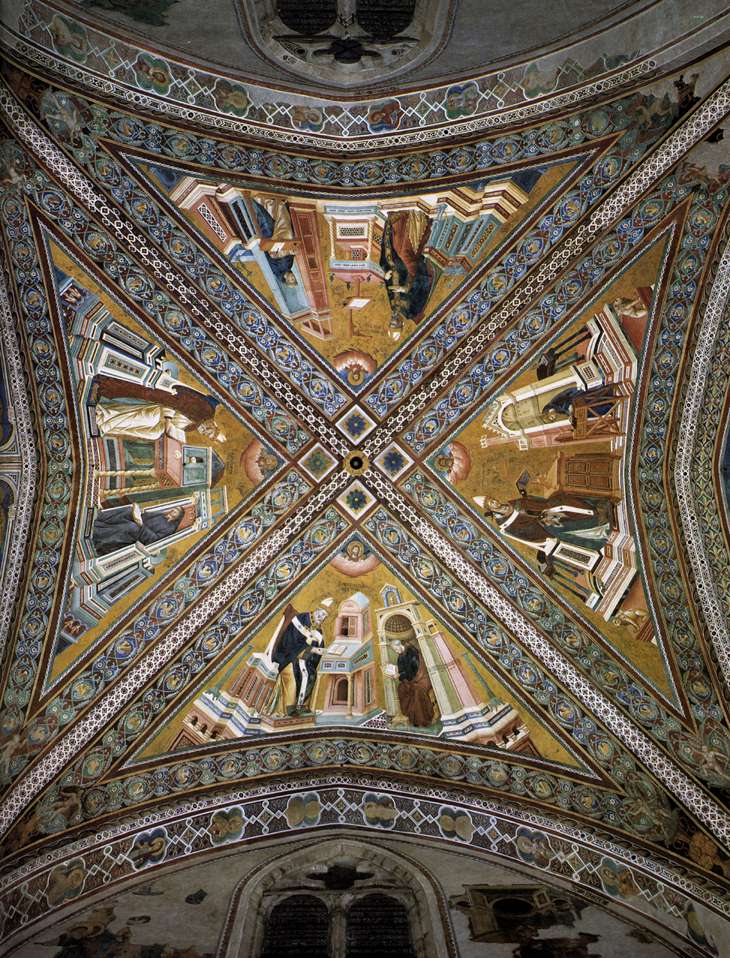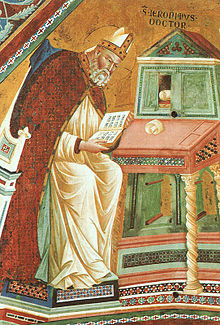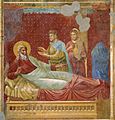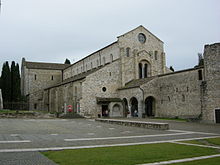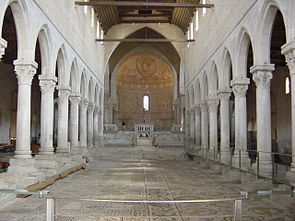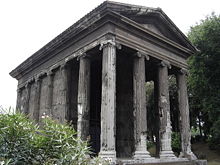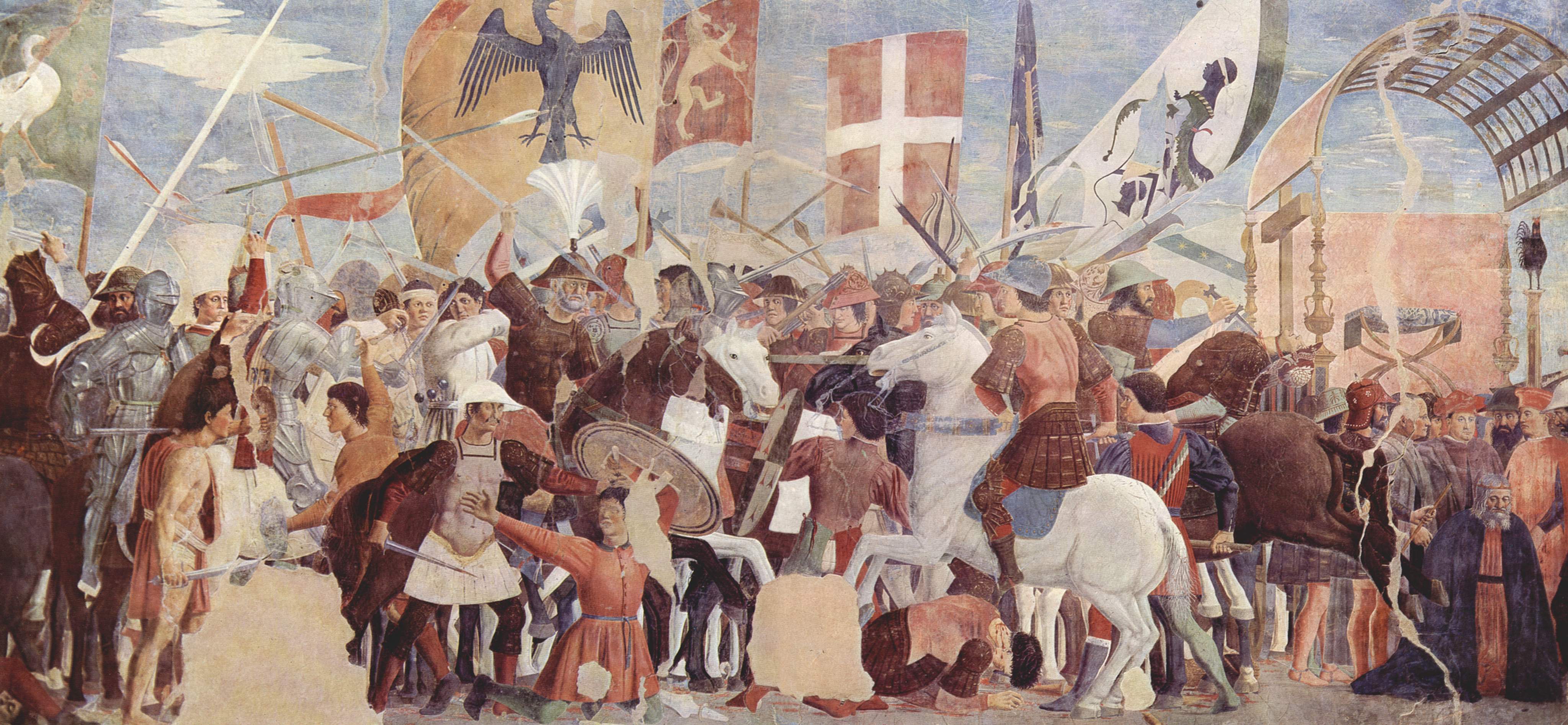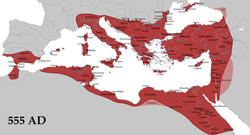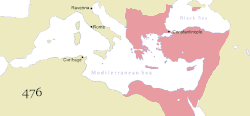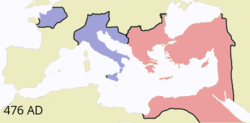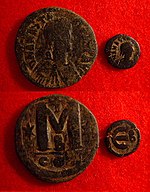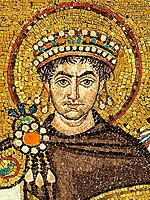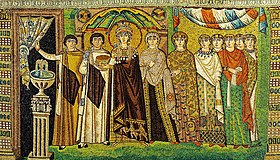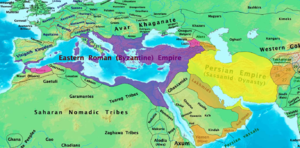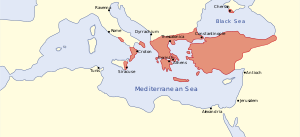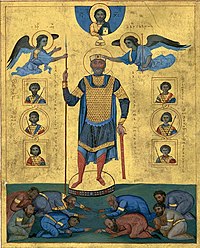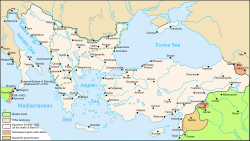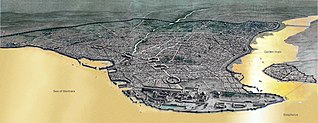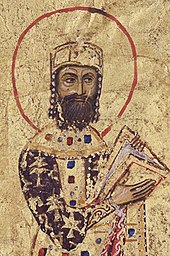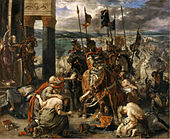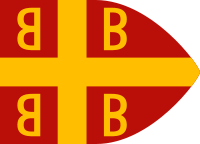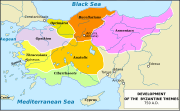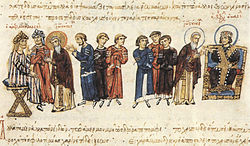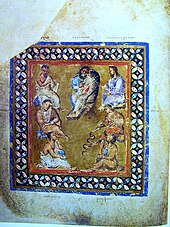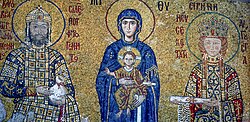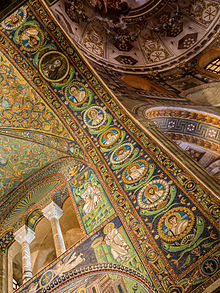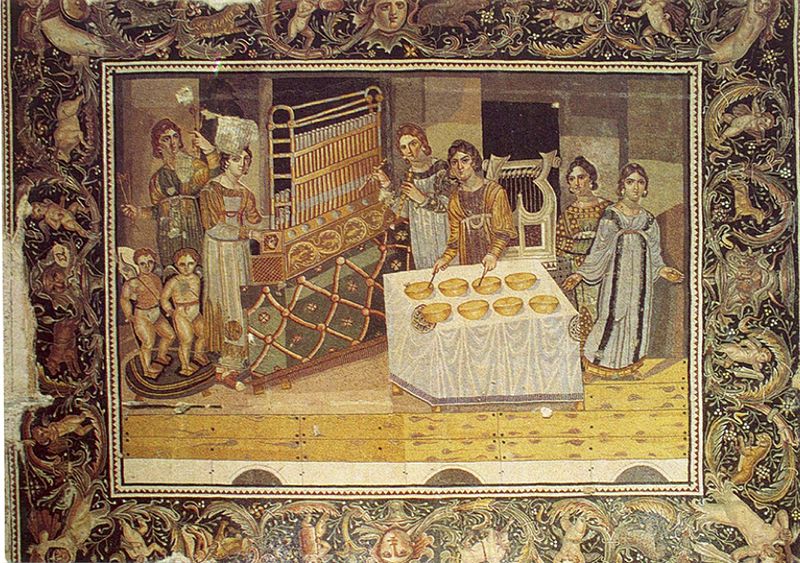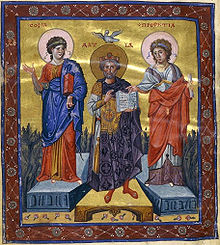Alexios’s son John II Komnenossucceeded him in 1118 and ruled until 1143. John was a pious and dedicated Emperor who was determined to undo the damage to the empire suffered at the Battle of Manzikert, half a century earlier.[133] Famed for his piety and his remarkably mild and just reign, John was an exceptional example of a moral ruler at a time when cruelty was the norm.[134] For this reason, he has been called the Byzantine Marcus Aurelius.
During his twenty-five year reign, John made alliances with the Holy Roman Empire in the West and decisively defeated the Pechenegs at the Battle of Beroia.[135] He thwarted Hungarian and Serbian threats during the 1120s, and in 1130 he allied himself with the German emperor Lothair III against the Norman king Roger II of Sicily.
In the later part of his reign, John focused his activities on the East, personally leading numerous campaigns against the Turks in Asia Minor. His campaigns fundamentally altered the balance of power in the East, forcing the Turks onto the defensive, while restoring many towns, fortresses, and cities across the peninsula to the Byzantines. He defeated the Danishmend Emirate of Melitene and reconquered all of Cilicia, while forcing Raymond of Poitiers, Prince of Antioch, to recognise Byzantine suzerainty. In an effort to demonstrate the Emperor’s role as the leader of the Christian world, John marched into the Holy Land at the head of the combined forces of the Empire and the Crusader states; yet despite his great vigour pressing the campaign, his hopes were disappointed by the treachery of his Crusader allies.[137] In 1142, John returned to press his claims to Antioch, but he died in the spring of 1143 following a hunting accident. Raymond was emboldened to invade Cilicia, but he was defeated and forced to go to Constantinople to beg mercy from the new Emperor.[138]
John’s chosen heir was his fourth son, Manuel I Komnenos, who campaigned aggressively against his neighbours both in the west and in the east. In Palestine, Manuel allied with the Crusader Kingdom of Jerusalem and sent a large fleet to participate in a combined invasion of Fatimid Egypt. Manuel reinforced his position as overlord of the Crusader states, with his hegemony over Antioch and Jerusalem secured by agreement with Raynald, Prince of Antioch, and Amalric, King of Jerusalem.[139] In an effort to restore Byzantine control over the ports of southern Italy, he sent an expedition to Italy in 1155, but disputes within the coalition led to the eventual failure of the campaign. Despite this military setback, Manuel’s armies successfully invaded the Southern parts of Kingdom of Hungary in 1167, defeating the Hungarians at the Battle of Sirmium. By 1168, nearly the whole of the eastern Adriatic coast lay in Manuel’s hands.[140] Manuel made several alliances with the Pope and Western Christian kingdoms, and he successfully handled the passage of the Second Crusade through his empire.[141]
In the east, however, Manuel suffered a major defeat in 1176 at the Battle of Myriokephalon, against the Turks. Yet the losses were quickly recovered, and in the following year Manuel’s forces inflicted a defeat upon a force of “picked Turks”.[142] The Byzantine commander John Vatatzes, who destroyed the Turkish invaders at the Battle of Hyelion and Leimocheir, not only brought troops from the capital but also was able to gather an army along the way, a sign that the Byzantine army remained strong and that the defensive program of western Asia Minor was still successful.[143]
12th-century Renaissance
John and Manuel pursued active military policies, and both deployed considerable resources on sieges and on city defences; aggressive fortification policies were at the heart of their imperial military policies.[144] Despite the defeat at Myriokephalon, the policies of Alexios, John and Manuel resulted in vast territorial gains, increased frontier stability in Asia Minor, and secured the stabilisation of the Empire’s European frontiers. From c. 1081 to c. 1180, the Komnenian army assured the Empire’s security, enabling Byzantine civilisation to flourish.[145]
This allowed the Western provinces to achieve an economic revival that continued until the close of the century. It has been argued that Byzantium under the Komnenian rule was more prosperous than at any time since the Persian invasions of the 7th century. During the 12th century, population levels rose and extensive tracts of new agricultural land were brought into production. Archaeological evidence from both Europe and Asia Minor shows a considerable increase in the size of urban settlements, together with a notable upsurge in new towns. Trade was also flourishing; the Venetians, the Genoese and others opened up the ports of the Aegean to commerce, shipping goods from the Crusader kingdoms of Outremer and Fatimid Egypt to the west and trading with the Empire via Constantinople.[146]
In artistic terms, there was a revival in mosaic, and regional schools of architecture began producing many distinctive styles that drew on a range of cultural influences.[147] During the 12th century, the Byzantines provided their model of early humanism as a renaissance of interest in classical authors. In Eustathius of Thessalonica, Byzantine humanism found its most characteristic expression.[148] In philosophy, there was resurgence of classical learning not seen since the 7th century, characterised by a significant increase in the publication of commentaries on classical works.[124] In addition, the first transmission of classical Greek knowledge to the West occurred during the Komnenian period.[125]
Decline and disintegration
Angelid dynasty

Byzantium in the late Angeloi period
Manuel’s death on 24 September 1180 left his 11-year-old son Alexios II Komnenos on the throne. Alexios was highly incompetent at the office, but it was his mother, Maria of Antioch, and her Frankish background that made his regency unpopular.[149]Eventually, Andronikos I Komnenos, a grandson of Alexios I, launched a revolt against his younger relative and managed to overthrow him in a violent coup d’état.[150] Utilizing his good looks and his immense popularity with the army, he marched on to Constantinople in August 1182 and incited a massacre of the Latins.[150] After eliminating his potential rivals, he had himself crowned as co-emperor in September 1183. He eliminated Alexios II, and took his 12-year-old wife Agnes of France for himself.[150]
Andronikos began his reign well; in particular, the measures he took to reform the government of the Empire have been praised by historians. According to George Ostrogorsky, Andronikos was determined to root out corruption: Under his rule, the sale of offices ceased; selection was based on merit, rather than favouritism; officials were paid an adequate salary so as to reduce the temptation of bribery. In the provinces, Andronikos’s reforms produced a speedy and marked improvement.[151] The aristocrats were infuriated against him, and to make matters worse, Andronikos seems to have become increasingly unbalanced; executions and violence became increasingly common, and his reign turned into a reign of terror.[152] Andronikos seemed almost to seek the extermination of the aristocracy as a whole. The struggle against the aristocracy turned into wholesale slaughter, while the Emperor resorted to ever more ruthless measures to shore up his regime.[151]
Despite his military background, Andronikos failed to deal with Isaac Komnenos, Béla III of Hungary (r. 1172–1196) who reincorporated Croatian territories into Hungary, and Stephen Nemanja of Serbia (r. 1166–1196) who declared his independence from the Byzantine Empire. Yet, none of these troubles would compare to William II of Sicily‘s (r. 1166–1189) invasion force of 300 ships and 80,000 men, arriving in 1185.[153] Andronikos mobilised a small fleet of 100 ships to defend the capital, but other than that he was indifferent to the populace. He was finally overthrown when Isaac Angelos, surviving an imperial assassination attempt, seized power with the aid of the people and had Andronikos killed.[154]
The reign of Isaac II, and more so that of his brother Alexios III, saw the collapse of what remained of the centralised machinery of Byzantine government and defence. Although the Normans were driven out of Greece, in 1186 the Vlachs and Bulgars began a rebellion that led to the formation of the Second Bulgarian Empire. The internal policy of the Angeloi was characterised by the squandering of the public treasure and fiscal maladministration. Imperial authority was severely weakened, and the growing power vacuum at the center of the Empire encouraged fragmentation. There is evidence that some Komnenian heirs had set up a semi-independent state in Trebizondbefore 1204.[155] According to Alexander Vasiliev, “the dynasty of the Angeloi, Greek in its origin, … accelerated the ruin of the Empire, already weakened without and disunited within.”[156]
Fourth Crusade
In 1198, Pope Innocent III broached the subject of a new crusade through legates and encyclical letters.[157] The stated intent of the crusade was to conquer Egypt, now the centre of Muslim power in the Levant. The crusader army that arrived at Venicein the summer of 1202 was somewhat smaller than had been anticipated, and there were not sufficient funds to pay the Venetians, whose fleet was hired by the crusaders to take them to Egypt. Venetian policy under the ageing and blind but still ambitious Doge Enrico Dandolo was potentially at variance with that of the Pope and the crusaders, because Venice was closely related commercially with Egypt.[158] The crusaders accepted the suggestion that in lieu of payment they assist the Venetians in the capture of the (Christian) port of Zara in Dalmatia (vassal city of Venice, which had rebelled and placed itself under Hungary’s protection in 1186).[159] The city fell in November 1202 after a brief siege.[160] Innocent tried to forbid this political attack on a Christian city, but was ignored. Reluctant to jeopardise his own agenda for the Crusade, he gave conditional absolution to the crusaders—not, however, to the Venetians.[158]
After the death of Theobald III, Count of Champagne, the leadership of the Crusade passed to Boniface of Montferrat, a friend of the Hohenstaufen Philip of Swabia. Both Boniface and Philip had married into the Byzantine Imperial family. In fact, Philip’s brother-in-law, Alexios Angelos, son of the deposed and blinded Emperor Isaac II Angelos, had appeared in Europe seeking aid and had made contacts with the crusaders. Alexios offered to reunite the Byzantine church with Rome, pay the crusaders 200,000 silver marks, join the crusade and provide all the supplies they needed to get to Egypt.[161] Innocent was aware of a plan to divert the Crusade to Constantinople and forbade any attack on the city, but the papal letter arrived after the fleets had left Zara.
Crusader sack of Constantinople (1204)
The crusaders arrived at Constantinople in the summer of 1203 and quickly attacked, starting a major fire that damaged large parts of the city, and briefly seized control. Alexios III fled from the capital and Alexios Angelos was elevated to the throne as Alexios IV along with his blind father Isaac. Alexios IV and Isaac II were unable to keep their promises and were deposed by Alexios V. The crusaders again took the city on 13 April 1204 and Constantinople was subjected to pillage and massacre by the rank and file for three days. Many priceless icons, relics and other objects later turned up in Western Europe, a large number in Venice. According to Choniates, a prostitute was even set up on the Patriarchal throne.[162] When Innocent III heard of the conduct of his crusaders, he castigated them in no uncertain terms but the situation was beyond his control, especially after his legate, on his own initiative, had absolved the crusaders from their vow to proceed to the Holy Land.[158] When order had been restored, the crusaders and the Venetians proceeded to implement their agreement; Baldwin of Flanders was elected Emperor of a new Latin Empire and the Venetian Thomas Morosini was chosen as Patriarch. The lands divided up among the leaders included most of the former Byzantine possessions, though resistance would continue through the Byzantine remnants of the Nicaea, Trebizond, and Epirus.[158] Although Venice was more interested in commerce than conquering territory, it took key areas of Constantinople and the Doge took the title of “Lord of a Quarter and Half a Quarter of the Roman Empire“.[163]
Fall
Empire in exile
After the sack of Constantinople in 1204 by Latin crusaders, two Byzantine successor states were established: the Empire of Nicaea, and the Despotate of Epirus. A third, the Empire of Trebizond, was created after Georgian expedition in Chaldia,[164] commanded by Alexios Komnenos a few weeks before the sack of Constantinople, who later found himself de facto emperor, and established himself in Trebizond. Of the three successor states, Epirus and Nicaea stood the best chance of reclaiming Constantinople. The Nicaean Empire struggled to survive the next few decades, however, and by the mid-13th century it had lost much of southern Anatolia.[165] The weakening of the Sultanate of Rûm following the Mongol invasion in 1242–43allowed many beyliks and ghazis to set up their own principalities in Anatolia, weakening the Byzantine hold on Asia Minor.[166] In time, one of the Beys, Osman I, created an empire that would eventually conquer Constantinople. However, the Mongol invasion also gave Nicaea a temporary respite from Seljuk attacks, allowing it to concentrate on the Latin Empire to its north.
Reconquest of Constantinople

The Byzantine Empire, c. 1263
The Empire of Nicaea, founded by the Laskarid dynasty, managed to effect theRecapture of Constantinoplefrom the Latins in 1261 and defeat Epirus. This led to a short-lived revival of Byzantine fortunes under Michael VIII Palaiologos but the war-ravaged Empire was ill-equipped to deal with the enemies that surrounded it. To maintain his campaigns against the Latins, Michael pulled troops from Asia Minor and levied crippling taxes on the peasantry, causing much resentment.[167] Massive construction projects were completed in Constantinople to repair the damage of the Fourth Crusade but none of these initiatives was of any comfort to the farmers in Asia Minor suffering raids from Muslim ghazis.[168]
Rather than holding on to his possessions in Asia Minor, Michael chose to expand the Empire, gaining only short-term success. To avoid another sacking of the capital by the Latins, he forced the Church to submit to Rome, again a temporary solution for which the peasantry hated Michael and Constantinople.[169] The efforts of Andronikos II and later his grandson Andronikos III marked Byzantium’s last genuine attempts in restoring the glory of the Empire. However, the use of mercenaries by Andronikos II would often backfire, with the Catalan Company ravaging the countryside and increasing resentment towards Constantinople.[170]
Rise of the Ottomans and fall of Constantinople
The situation became worse for Byzantium during the civil wars after Andronikos III died. A six-year-long civil wardevastated the empire, allowing the Serbian ruler Stefan Dušan (r. 1331–1346) to overrun most of the Empire’s remaining territory and establish a Serbian Empire. In 1354, an earthquake at Gallipolidevastated the fort, allowing the Ottomans(who were hired as mercenaries during the civil war by John VI Kantakouzenos) to establish themselves in Europe.[171] By the time the Byzantine civil wars had ended, the Ottomans had defeated the Serbians and subjugated them as vassals. Following the Battle of Kosovo, much of the Balkans became dominated by the Ottomans.[172]
The Byzantine emperors appealed to the West for help, but the Pope would only consider sending aid in return for a reunion of the Eastern Orthodox Church with the See of Rome. Church unity was considered, and occasionally accomplished by imperial decree, but the Orthodox citizenry and clergy intensely resented the authority of Rome and the Latin Rite.[173] Some Western troops arrived to bolster the Christian defence of Constantinople, but most Western rulers, distracted by their own affairs, did nothing as the Ottomans picked apart the remaining Byzantine territories.[174]
Constantinople by this stage was underpopulated and dilapidated. The population of the city had collapsed so severely that it was now little more than a cluster of villages separated by fields. On 2 April 1453, Sultan Mehmed‘s army of 80,000 men and large numbers of irregulars laid siege to the city.[175] Despite a desperate last-ditch defence of the city by the massively outnumbered Christian forces (c. 7,000 men, 2,000 of whom were foreign),[174] Constantinople finally fell to the Ottomans after a two-month siege on 29 May 1453. The last Byzantine emperor, Constantine XI Palaiologos, was last seen casting off his imperial regalia and throwing himself into hand-to-hand combat after the walls of the city were taken.[176]
Political aftermath
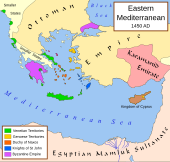
The Eastern Mediterranean just before the fall of Constantinople
By the time of the fall of Constantinople, the only remaining territory of the Byzantine Empire was the Despotate of the Morea(Peloponnese), which was ruled by brothers of the last Emperor, Thomas Palaiologos and Demetrios Palaiologos. The Despotate continued on as an independent state by paying an annual tribute to the Ottomans. Incompetent rule, failure to pay the annual tribute and a revolt against the Ottomans finally led to Mehmed II’s invasion of Morea in May 1460. Demetrios asked the Ottomans to invade and drive Thomas out. Thomas fled. The Ottomans moved through the Morea and conquered virtually the entire Despotate by the summer. Demetrios thought the Morea would be restored to him to rule, but it was incorporated into the Ottoman fold.
A few holdouts remained for a time. The island of Monemvasia refused to surrender and it was first ruled for a short time by an Aragonese corsair. When the population drove him out they obtained the consent of Thomas to place themselves under the Pope’s protection before the end of 1460. The Mani Peninsula, on the Morea’s south end, resisted under a loose coalition of the local clans and then that area came under Venice’s rule. The very last holdout was Salmeniko, in the Morea’s northwest. Graitzas Palaiologos was the military commander there, stationed at Salmeniko Castle. While the town eventually surrendered, Graitzas and his garrison and some town residents held out in the castle until July 1461, when they escaped and reached Venetian territory.[177]
The Empire of Trebizond, which had split away from the Byzantine Empire just weeks before Constantinople was taken by the Crusaders in 1204, became the last remnant and last de facto successor state to the Byzantine Empire. Efforts by the Emperor David to recruit European powers for an anti-Ottoman crusade provoked war between the Ottomans and Trebizond in the summer of 1461. After a month-long siege, David surrendered the city of Trebizond on 14 August 1461. The Empire of Trebizond’s Crimean principality, the Principality of Theodoro (part of the Perateia), lasted another 14 years, falling to the Ottomans in December 1475.
A nephew of the last Emperor, Constantine XI, Andreas Palaiologosclaimed to have inherited the title of Byzantine Emperor. He lived in the Morea until its fall in 1460, then escaped to Rome where he lived under the protection of the Papal States for the remainder of his life. Since the office of emperor had never been technically hereditary, Andreas’ claim would have been without merit under Byzantine law. However, the Empire had vanished, and Western states generally followed the Roman-church-sanctioned principles of hereditary sovereignty. Seeking a life in the west, Andreas styled himself Imperator Constantinopolitanus (“Emperor of Constantinople”), and sold his succession rights to both Charles VIII of France and the Catholic Monarchs.

The Russians supported the idea that Moscow was the proper heir to Rome and Constantinople. Territorial expansion of Russia (1533-1894).
Constantine XI died without producing an heir, and had Constantinople not fallen he might have been succeeded by the sons of his deceased elder brother, who were taken into the palace service of Mehmed II after the fall of Constantinople. The oldest boy, renamed Has Murad, became a personal favorite of Mehmed and served as Beylerbey (Governor-General) of the Balkans. The younger son, renamed Mesih Pasha, became Admiral of the Ottoman fleet and Sancak Beg (Governor) of the Province of Gallipoli. He eventually served twice as Grand Vizier under Mehmed’s son, Bayezid II.[178]
Mehmed II and his successors continued to consider themselves heirs to the Roman Empire until the demise of the Ottoman Empire in the early 20th century following World War 1. They considered that they had simply shifted its religious basis as Constantine had done before, and they continued to refer to their conquered Eastern Roman inhabitants (Orthodox Christians) as Rûm. Meanwhile, the Danubian Principalities (whose rulers also considered themselves the heirs of the Eastern Roman Emperors[179]) harboured Orthodox refugees, including some Byzantine nobles.
At his death, the role of the emperor as a patron of Eastern Orthodoxy was claimed by Ivan III, Grand duke of Muscovy. He had married Andreas’ sister, Sophia Paleologue, whose grandson, Ivan IV, would become the first Tsar of Russia (tsar, or czar, meaning caesar, is a term traditionally applied by Slavs to the Byzantine Emperors). Their successors supported the idea that Moscow was the proper heir to Rome and Constantinople. The idea of the Russian Empire as the successive Third Rome was kept alive until its demise with the Russian Revolution.[180]
Government and bureaucracy
In the Byzantine state, the emperor was the sole and absolute ruler, and his power was regarded as having divine origin.[181] The Senatehad ceased to have real political and legislative authority but remained as an honorary council with titular members. By the end of the 8th century, a civil administration focused on the court was formed as part of a large-scale consolidation of power in the capital (the rise to pre-eminence of the position of sakellarios is related to this change).[182]The most important administrative reform, which probably started in the mid-7th century, was the creation of themes, where civil and military administration was exercised by one person, the strategos.[183]
Despite the occasionally derogatory use of the terms “Byzantine” and “Byzantinism“, the Byzantine bureaucracy had a distinct ability for reconstituting itself in accordance with the Empire’s situation. The elaborate system of titulature and precedence gave the court prestige and influence. Officials were arranged in strict order around the emperor, and depended upon the imperial will for their ranks. There were also actual administrative jobs, but authority could be vested in individuals rather than offices.[184]
In the 8th and 9th centuries, civil service constituted the clearest path to aristocratic status, but, starting in the 9th century, the civil aristocracy was rivalled by an aristocracy of nobility. According to some studies of Byzantine government, 11th-century politics were dominated by competition between the civil and the military aristocracy. During this period, Alexios I undertook important administrative reforms, including the creation of new courtly dignities and offices.[185]
Diplomacy
After the fall of Rome, the key challenge to the Empire was to maintain a set of relations between itself and its neighbours. When these nations set about forging formal political institutions, they often modelled themselves on Constantinople. Byzantine diplomacy soon managed to draw its neighbours into a network of international and inter-state relations.[186] This network revolved around treaty making, and included the welcoming of the new ruler into the family of kings, and the assimilation of Byzantine social attitudes, values and institutions.[187] Whereas classical writers are fond of making ethical and legal distinctions between peace and war, Byzantines regarded diplomacy as a form of war by other means. For example, a Bulgarian threat could be countered by providing money to the Kievan Rus’.[188]
Diplomacy in the era was understood to have an intelligence-gathering function on top of its pure political function. The Bureau of Barbariansin Constantinople handled matters of protocol and record keeping for any issues related to the “barbarians“, and thus had, perhaps, a basic intelligence function itself.[189] John B. Bury believed that the office exercised supervision over all foreigners visiting Constantinople, and that they were under the supervision of the Logothetes tou dromou.[190] While on the surface a protocol office – its main duty was to ensure foreign envoys were properly cared for and received sufficient state funds for their maintenance, and it kept all the official translators – it probably had a security function as well.[191]
Byzantines availed themselves of a number of diplomatic practices. For example, embassies to the capital would often stay on for years. A member of other royal houses would routinely be requested to stay on in Constantinople, not only as a potential hostage, but also as a useful pawn in case political conditions where he came from changed. Another key practice was to overwhelm visitors by sumptuous displays.[186] According to Dimitri Obolensky, the preservation of the ancient civilisation in Europe was due to the skill and resourcefulness of Byzantine diplomacy, which remains one of Byzantium’s lasting contributions to the history of Europe.[192]
Science, medicine and law

Interior panorama of the Hagia Sophia, the patriarchal basilica in Constantinople designed 537 CE by Isidore of Miletus, the first compiler of Archimedes’ various works. The influence of Archimedes’ principles of solid geometry is evident.
The writings of Classical antiquity were cultivated and extended in Byzantium. Therefore, Byzantine science was in every period closely connected with ancient philosophy, and metaphysics.[193] In the field of engineering Isidore of Miletus, the Greek mathematician and architect of the Hagia Sophia, produced the first compilation of Archimedes‘ works c. 530, and it is through this manuscript tradition, kept alive by the school of mathematics and engineering founded c. 850 during the “Byzantine Renaissance” by Leo the Geometer, that such works are known today (see Archimedes Palimpsest).[194]
Byzantines stood behind several technological advancements.
Pendentive architecture, a specific spherical form in the upper corners to support a dome, is a Byzantine invention. Although the first experimentation was made in the 200s, it was in the 6th-century in Byzantine Empire that its potential was fully achieved.[195]
A mechanical sundial device consisting of complex gears made by the Byzantines has been excavated which indicates that the Antikythera mechanism, a sort of analog mechanism used in astronomy invented around the late second century BC, continued to be (re)active in the Byzantine period.[196][197][198] J. R. Partington writes that
Constantinople was full of inventors and craftsmen. The “philosopher” Leo of Thessalonika made for the Emperor Theophilos (829–42) a golden tree, the branches of which carried artificial birds which flapped their wings and sang, a model lion which moved and roared, and a bejewelled clockwork lady who walked. These mechanical toys continued the tradition represented in the treatise of Heron of Alexandria (c. A.D. 125), which was well-known to the Byzantines.[199]
Such mechanical devices reached high level of sophistication and were made in order to impress the visitors.[200]
Leo the Mathematician has also been credited with the system of beacons, a sort of optical telegraph, stretching across Anatolia from Cilicia to Constantinople, which gave advance warning of enemy raids, and which was used as diplomatic communication as well.
The Byzantines knew and used the concept of hydraulic: in the 900s the diplomat Liutprand of Cremona, when visiting the Byzantine emperor, explained that he saw the emperor sitting on a hydraulic throne and that it was “made in such a cunning manner that at one moment it was down on the ground, while at another it rose higher and was seen to be up in the air”.[201]
John Philoponus, an Alexandrian philologist, Aristotelian commentator and Christian theologian, author of a considerable number of philosophical treatises and theological works, was the first who questioned Aristotle’s teaching of physics. Before that nobody questioned Aristotle’s teaching of physics despite it had flaws.
Aristotle’s physics was not scrutinized until John Philoponus appeared, and unlike Aristotle who based his physics on verbal argument, Philoponus relied on observation. On Aristotle’s physics John Philoponus wrote:
But this is completely erroneous, and our view may be corroborated by actual observation more effectively than by any sort of verbal argument. For if you let fall from the same height two weights of which one is many times as heavy as the other, you will see that the ratio of the times required for the motion does not depend on the ratio of the weights, but that the difference in time is a very small one. And so, if the difference in the weights is not considerable, that is, of one is, let us say, double the other, there will be no difference, or else an imperceptible difference, in time, though the difference in weight is by no means negligible, with one body weighing twice as much as the other.[202]
John Philoponus’ criticism of Aristotelian principles of physics was an inspiration for Galileo Galilei many centuries later, as Galileo cited Philoponus substantially in his works, and was the reason why Galileo also refuted Aristotelian physics during the Scientific Revolution.[203][204]
Ship mill is an invention made by the Byzantines, and was constructed in order to mil grains by using the energy of the stream of water. The technology eventually spread to the rest of Europe and was in use until ca. 1800.[205][206]
In 438 a codification of the laws and decrees found place in the Codex Theodosianus named after Theodosius II. It went into force not just in the Eastern Roman/Byzantine Empire, but also in the Western Roman Empire. It summarized the laws and gave directions how to interpret the laws.
Under the reign of Justinian I it was Tribonian, a notable jurist in the empire, who supervised the revision of the legal code known today as Corpus Juris Civilis. In the field of law, Justinian I‘s reforms had a clear effect on the evolution of jurisprudence, with his Corpus Juris Civilisbecoming the basis for revived Roman law in the Western world, while Leo III’s Ecloga influenced the formation of legal institutions in the Slavic world.[207]
In the 10th century, Leo VI the Wise achieved the complete codification of the whole of Byzantine law in Greek with the Basilika, which became the foundation of all subsequent Byzantine law with an influence extending through to modern Balkan legal codes.[105]
The concept of hospital as institution to offer medical care and possibility of a cure for the patients due to the ideals of Christian charity, rather than just merely a place to die, appeared in Byzantine Empire.[208]
Although the concept of uroscopy was known to Galen, he did not see the importance of using it to localize the disease. It was under the Byzantines with physicians such of Theophilus Protospatharius that they realized the potential in uroscopy to determine disease in a time when no microscope or stethoscope existed. That practice eventually spread to the rest of Europe.[209]
In medicine the works of Byzantine doctors, such as the Vienna Dioscorides (6th century), and works of Paul of Aegina (7th century) and Nicholas Myrepsos (late 13th century), continued to be used as the authoritative texts by Europeans through the Renaissance.
The first known example of separating conjoined twins happened in the Byzantine Empire in the 10th century when a pair of conjoined twins from Armenia came eventually to Constantinople. Many years later one of them died, so the surgeons in Constantinople decided to remove the body of the dead one. The result was partly successful as the surviving twin lived in three days before dying. But the fact that the second person survived for few days after separating it, was so impressive that it was mentioned a century and half years later again by historians. The next case of separating conjoined twins will be recorded first about 700 years later in the year 1689 in Germany.[210][211]
Greek Fire, an incendirary weapon which could even burn on water is also attributed to the Byzantines. It played a crucial role when the Byzantine Empire defeated the Umayyad Caliphate during the Siege of Constantinople (717–718).[212] The discovery is attributed to Callinicus of Heliopolis from Syria, a Byzantine Jew who fled during the Arab conquest of Syria. However, it has also been argued that no single person invented the Greek fire, but that it was rather “invented by the chemists in Constantinople who had inherited the discoveries of the Alexandrian chemical school…”.[199]
The first example of a grenade also appeared in Byzantine Empire, where rudimentary incendiary grenades made of ceramic jars holding glass or nails were made and used on battlefields.[213][214][215]
In the final century of the Empire, astronomy and other mathematical sciences were taught in Trebizond; medicine attracted the interest of almost all scholars.[216]
The Fall of Constantinople in 1453 fueled the era later commonly known as “Renaissance” in Italy. During this period, refugee Byzantine scholars were principally responsible for carrying, in person and in writing, ancient Greek grammatical, literary studies, mathematical, and astronomical knowledge to early Renaissance Italy.[217] They also brought with them classical learning and texts such of botany, medicine and zoology, and the Greek scholars brought important inputs to the West such of the works of Dioscorides and John Philoponus‘ criticism of Aristotelian physics.[218] The latter served as an inspiration for Galileo Galilei in the Scientific Revolution.[219]
Culture
Religion
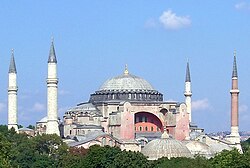
As a symbol and expression of the universal prestige of the Patriarchate of Constantinople, Justinian built the Church of the Holy Wisdom of God, Hagia Sophia, which was completed in the short period of four and a half years (532–537)
The Byzantine Empire was a theocracy, said to be ruled by God working through the Emperor. Jennifer Fretland VanVoorst argues, “The Byzantine Empire became a theocracy in the sense that Christian values and ideals were the foundation of the empire’s political ideals and heavily entwined with its political goals.”[220] Steven Runciman says in his book on The Byzantine Theocracy (2004):
The constitution of the Byzantine Empire was based on the conviction that it was the earthly copy of the Kingdom of Heaven. Just as God ruled in Heaven, so the Emperor, made in his image, should rule on earth and carry out his commandments … It saw itself as a universal empire. Ideally, it should embrace all the peoples of the Earth who, ideally, should all be members of the one true Christian Church, its own Orthodox Church. Just as man was made in God’s image, so man’s kingdom on Earth was made in the image of the Kingdom of Heaven.[221]
The survival of the Empire in the East assured an active role of the Emperor in the affairs of the Church. The Byzantine state inherited from pagan times the administrative, and financial routine of administering religious affairs, and this routine was applied to the Christian Church. Following the pattern set by Eusebius of Caesarea, the Byzantines viewed the Emperor as a representative or messenger of Christ, responsible particularly for the propagation of Christianity among pagans, and for the “externals” of the religion, such as administration and finances. As Cyril Mango points out, the Byzantine political thinking can be summarised in the motto “One God, one empire, one religion”.[222]
The imperial role in the affairs of the Church never developed into a fixed, legally defined system.[223] With the decline of Rome, and internal dissension in the other Eastern Patriarchates, the Church of Constantinople became, between the 6th and 11th centuries, the richest and most influential center of Christendom.[224] Even when the Empire was reduced to only a shadow of its former self, the Church continued to exercise significant influence both inside and outside of the imperial frontiers. As George Ostrogorsky points out:
The Patriarchate of Constantinople remained the center of the Orthodox world, with subordinate metropolitan seesand archbishoprics in the territory of Asia Minor and the Balkans, now lost to Byzantium, as well as in Caucasus, Russia and Lithuania. The Church remained the most stable element in the Byzantine Empire.[225]
The official state Christian doctrine was determined by the first seven ecumenical councils, and it was then the emperor’s duty to impose it to his subjects. An imperial decree of 388, which was later incorporated into the Codex Justinianus, orders the population of the Empire “to assume the name of Catholic Christians”, and regards all those who will not abide by the law as “mad and foolish persons”; as followers of “heretical dogmas”.[226]
Despite imperial decrees and the stringent stance of the state church itself, which came to be known as the Eastern Orthodox Church or Eastern Christianity, the latter never represented all Christians in Byzantium. Mango believes that, in the early stages of the Empire, the “mad and foolish persons”, those labelled “heretics” by the state church, were the majority of the population.[227] Besides the pagans, who existed until the end of the 6th century, and the Jews, there were many followers – sometimes even emperors – of various Christian doctrines, such as Nestorianism, Monophysitism, Arianism, and Paulicianism, whose teachings were in some opposition to the main theological doctrine, as determined by the Ecumenical Councils.[228]
Another division among Christians occurred, when Leo III ordered the destruction of icons throughout the Empire. This led to a significant religious crisis, which ended in mid-9th century with the restoration of icons. During the same period, a new wave of pagans emerged in the Balkans, originating mainly from Slavic people. These were gradually Christianised, and by Byzantium’s late stages, Eastern Orthodoxy represented most Christians and, in general, most people in what remained of the Empire.[229]
Jews were a significant minority in the Byzantine state throughout its history, and, according to Roman law, they constituted a legally recognised religious group. In the early Byzantine period they were generally tolerated, but then periods of tensions and persecutions ensued. In any case, after the Arab conquests, the majority of Jews found themselves outside the Empire; those left inside the Byzantine borders apparently lived in relative peace from the 10th century onwards.[230]
Georgian monasteries first appear in Constantinople and on Mount Olympos in northwestern Asia Minor in the second half of the ninth century, and from then on Georgians played an increasingly important role in the Empire.[231]
The arts
Art and literature

Miniatures of the 6th-century Rabula Gospel display the more abstract and symbolic nature of Byzantine art.
Surviving Byzantine art is mostly religious and with exceptions at certain periods is highly conventionalised, following traditional models that translate carefully controlled church theology into artistic terms. Painting in fresco, illuminated manuscripts and on wood panel and, especially in earlier periods, mosaic were the main media, and figurative sculpture very rare except for small carved ivories. Manuscript painting preserved to the end some of the classical realist tradition that was missing in larger works.[232] Byzantine art was highly prestigious and sought-after in Western Europe, where it maintained a continuous influence on medieval art until near the end of the period. This was especially so in Italy, where Byzantine styles persisted in modified form through the 12th century, and became formative influences on Italian Renaissance art. But few incoming influences affected Byzantine style. By means of the expansion of the Eastern Orthodox church, Byzantine forms and styles spread to all the Orthodox world and beyond.[233] Influences from Byzantine architecture, particularly in religious buildings, can be found in diverse regions from Egypt and Arabia to Russia and Romania.
In Byzantine literature, four different cultural elements are recognised: the Greek, the Christian, the Roman, and the Oriental. Byzantine literature is often classified in five groups: historians and annalists, encyclopaedists (Patriarch Photios, Michael Psellus, and Michael Choniates are regarded as the greatest encyclopaedists of Byzantium) and essayists, and writers of secular poetry. The only genuine heroic epic of the Byzantines is the Digenis Acritas. The remaining two groups include the new literary species: ecclesiastical and theological literature, and popular poetry.[234]
Of the approximately two to three thousand volumes of Byzantine literature that survive, only 330 consist of secular poetry, history, science and pseudo-science.[234] While the most flourishing period of the secular literature of Byzantium runs from the 9th to the 12th century, its religious literature (sermons, liturgical books and poetry, theology, devotional treatises, etc.) developed much earlier with Romanos the Melodist being its most prominent representative.[235]
Music
The ecclesiastical forms of Byzantine music, composed to Greek texts as ceremonial, festival, or church music,[237] are, today, the most well-known forms. Ecclesiastical chants were a fundamental part of this genre. Greek and foreign historians agree that the ecclesiastical tones and in general the whole system of Byzantine music is closely related to the ancient Greek system.[238] It remains the oldest genre of extant music, of which the manner of performance and (with increasing accuracy from the 5th century onwards) the names of the composers, and sometimes the particulars of each musical work’s circumstances, are known.

Earliest known depiction of a bowed lyra, from a Byzantine ivory casket (900 – 1100 AD). (Museo Nazionale, Florence)
The 9th century Persian geographer Ibn Khurradadhbih (d. 911); in his lexicographical discussion of instruments cited the lyra (lūrā) as the typical instrument of the Byzantines along with the urghun (organ), shilyani(probably a type of harp or lyre) and the salandj (probably a bagpipe).[239]The first of these, the early bowed stringed instrument known as the Byzantine lyra, would come to be called the lira da braccio,[240] in Venice, where it is considered by many to have been the predecessor of the contemporary violin, which later flourished there.[241] The bowed “lyra” is still played in former Byzantine regions, where it is known as the Politiki lyra (lit. “lyra of the City” i.e. Constantinople) in Greece, the Calabrian lira in Southern Italy, and the Lijerica in Dalmatia. The second instrument, the organ, originated in the Hellenistic world (see Hydraulis) and was used in the Hippodrome during races.[242][243] A pipe organ with “great leaden pipes” was sent by the emperor Constantine V to Pepin the Short, King of the Franks in 757. Pepin’s son Charlemagne requested a similar organ for his chapel in Aachenin 812, beginning its establishment in Western church music.[243] The final Byzantine instrument, the aulos was a double reeded woodwind like the modern oboe or Armenian duduk. Other forms include the plagiaulos (πλαγίαυλος, from πλάγιος “sideways”), which resembled the flute,[244] and the askaulos (ἀσκός askos – wine-skin), a bagpipe.[245] These bagpipes, also known as Dankiyo (from ancient Greek: angion (Τὸ ἀγγεῖον) “the container”), had been played even in Roman times. Dio Chrysostom wrote in the 1st century of a contemporary sovereign (possibly Nero) who could play a pipe (tibia, Roman reedpipes similar to Greek aulos) with his mouth as well as by tucking a bladder beneath his armpit.[246] The bagpipes continued to be played throughout the empire’s former realms through to the present. (See Balkan Gaida, Greek Tsampouna, Pontic Tulum, Cretan Askomandoura, Armenian Parkapzuk, and Romanian Cimpoi.)
Cuisine
The Byzantine culture was, initially, the same as Late Greco-Roman, but over the following millennium of the empire’s existence it slowly changed into something more similar to modern Balkan and Anatolian culture. The cuisine still relied heavily on the Greco-Roman fish-sauce condiment garos, but it also contained foods still familiar today, such as the cured meat pastirma (known as “paston” in Byzantine Greek),[247][248][249]baklava (known as koptoplakousκοπτοπλακοῦς),[250] tiropita (known as plakountas tetyromenous or tyritas plakountas),[251] and the famed medieval sweet wines (Commandaria and the eponymous Rumney wine). Retsina, wine flavored with pine resin, was also drunk, as it still is in Greece today, producing similar reactions from unfamiliar visitors; “To add to our calamity the Greek wine, on account of being mixed with pitch, resin, and plaster was to us undrinkable,” complained Liutprand of Cremona, who was the ambassador sent to Constantinople in 968 by the German Holy Roman Emperor Otto I.[252] The garos fish sauce condiment was also not much appreciated by the unaccustomed; Liutprand of Cremona described being served food covered in an “exceedingly bad fish liquor.”[252] The Byzantines also used a soy sauce like condiment, murri, a fermented barley sauce, which, like soy sauce, provided umami flavoring to their dishes.[253][254]
Flags and insignia

The double-headed imperial eagle, a common Imperial symbol
For most of its history, the Byzantine Empire did not know or use heraldry in the West European sense. Various emblems (Greek: σημεία, sēmeia; sing. σημείον, sēmeion) were used in official occasions and for military purposes, such as banners or shields displaying various motifs such as the cross or the labarum. The use of the cross, and of images of Christ, the Virgin Mary and various saints is also attested on seals of officials, but these were personal rather than family emblems.
Language
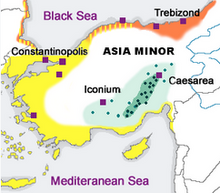
Distribution of Greek dialects in Anatolia in the late Byzantine Empire through to 1923. Demotic in yellow. Pontic in orange. Cappadocian in green. (Green dots indicate Cappadocian Greek speaking villages in 1910.[256])
Apart from the Imperial court, administration and military, the primary language used in the eastern Roman provinces even before the decline of the Western Empire was Greek, having been spoken in the region for centuries before Latin.[257] Following Rome’s conquest of the east its ‘Pax Romana’, inclusionist political practices and development of public infrastructure, facilitated the further spreading and entrenchment of Greek language in the east. Indeed, early on in the life of the Roman Empire, Greek had become the common language of the Church, the language of scholarship and the arts, and, to a large degree, the lingua franca for trade between provinces and with other nations.[258] Greek for a time became diglossic with the spoken language, known as Koine (eventually evolving into Demotic Greek), used alongside an older written form until Koine won out as the spoken and written standard.[259]
The emperor Diocletian (reigned 284–305) sought to renew the authority of Latin, making it the official language of the Roman administration also in the East, and the Greek expression ἡ κρατοῦσα διάλεκτος (hē kratousa dialektos) attests to the status of Latin as “the language of power.”[260] The scholar Libanius (4th century) regarded Latin as causing a decline in the quality of Greek rhetoric[261] as the study of Latin became necessary for those who wanted to occupy public offices. In the early 5th century, Greek gained equal status with Latin as official language in the East and emperors gradually began to legislate in Greek rather than Latin starting with the reign of Leo I the Thracian in the 460s[262]. The last Eastern emperor to stress the importance of Latin was Justinian I (reigned AD 527-565), whose Corpus Juris Civilis was written almost entirely in Latin. He may also have been the last native Latin-speaking emperor[263].
The use of Latin as the language of administration persisted until adoption of Greek as the sole official language by Heraclius in the 7th century. Scholarly Latin would rapidly fall into disuse among the educated classes although the language would continue to be at least a ceremonial part of the Empire’s culture for some time.[264]Additionally, Latin remained a minority language in the Empire, mainly in Italian peninsula and along Dalmatian coast, eventually developing into various Romance languages like Dalmatian.[265]
Many other languages existed in the multi-ethnic Empire, and some of these were given limited official status in their provinces at various times. Notably, by the beginning of the Middle Ages, Syriac had become more widely used by the educated classes in the far eastern provinces.[266] Similarly Coptic, Armenian, and Georgian became significant among the educated in their provinces,[267]. Later foreign contacts made Old Church Slavic, Middle Persian, and Arabicimportant in the Empire and its sphere of influence.[268] There was a revival of Latin studies in the tenth century for the same reason and by the eleventh century as knowledge of Latin was no longer unusual at Constantinople [269].
Aside from these languages, since Constantinople was a prime trading center in the Mediterranean region and beyond, virtually every known language of the Middle Ages was spoken in the Empire at some time, even Chinese.[270] As the Empire entered its final decline, the Empire’s citizens became more culturally homogeneous and the Greek language became integral to their identity and religion.[271]
Recreation

A game of τάβλι (tabula) played by Byzantine emperor Zeno in 480 and recorded by Agathias in c. 530 because of a very unlucky dice throw for Zeno (red), as he threw 2, 5 and 6 and was forced to leave eight pieces alone.[272]
Byzantines were avid players of tavli (Byzantine Greek: τάβλη), a game known in English as backgammon, which is still popular in former Byzantine realms, and still known by the name tavli in Greece.[272] Byzantine nobles were devoted to horsemanship, particularly tzykanion, now known as polo. The game came from Sassanid Persia in the early period and a Tzykanisterion (stadium for playing the game) was built by Theodosius II (r. 408–450) inside the Great Palace of Constantinople. Emperor Basil I (r. 867–886) excelled at it; Emperor Alexander (r. 912–913) died from exhaustion while playing, Emperor Alexios I Komnenos (r. 1081–1118) was injured while playing with Tatikios, and John I of Trebizond (r. 1235–1238) died from a fatal injury during a game.[273][274] Aside from Constantinople and Trebizond, other Byzantine cities also featured tzykanisteria, most notably Sparta, Ephesus, and Athens, an indication of a thriving urban aristocracy.[275]The game was introduced to the West by crusaders, who developed a taste for it particularly during the pro-Western reign of emperor Manuel I Komnenos.
Economy
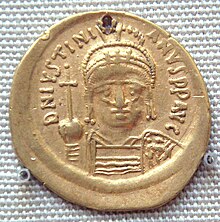
Gold coin of Justinian I (527–565 CE) excavated in India probably in the south, an example of Indo-Roman trade during the period.
The Byzantine economy was among the most advanced in Europe and the Mediterraneanfor many centuries. Europe, in particular, could not match Byzantine economic strength until late in the Middle Ages. Constantinople operated as a prime hub in a trading network that at various times extended across nearly all of Eurasiaand North Africa, in particular as the primary western terminus of the famous Silk Road. Until the first half of the 6th century and in sharp contrast with the decaying West, the Byzantine economy was flourishing and resilient.[276]
The Plague of Justinian and the Arab conquests would represent a substantial reversal of fortunes contributing to a period of stagnation and decline. Isaurian reforms and, in particular, Constantine V‘s repopulation, public works and tax measures, marked the beginning of a revival that continued until 1204, despite territorial contraction.[277] From the 10th century until the end of the 12th, the Byzantine Empire projected an image of luxury and travellers were impressed by the wealth accumulated in the capital.[278]
The Fourth Crusade resulted in the disruption of Byzantine manufacturing and the commercial dominance of the Western Europeans in the eastern Mediterranean, events that amounted to an economic catastrophe for the Empire.[278] The Palaiologoi tried to revive the economy, but the late Byzantine state would not gain full control of either the foreign or domestic economic forces. Gradually, it also lost its influence on the modalities of trade and the price mechanisms, and its control over the outflow of precious metals and, according to some scholars, even over the minting of coins.[279]
One of the economic foundations of Byzantium was trade, fostered by the maritime character of the Empire. Textiles must have been by far the most important item of export; silks were certainly imported into Egypt, and appeared also in Bulgaria, and the West.[280] The state strictly controlled both the internal and the international trade, and retained the monopoly of issuing coinage, maintaining a durable and flexible monetary system adaptable to trade needs.[281]
The government attempted to exercise formal control over interest rates, and set the parameters for the activity of the guilds and corporations, in which it had a special interest. The emperor and his officials intervened at times of crisis to ensure the provisioning of the capital, and to keep down the price of cereals. Finally, the government often collected part of the surplus through taxation, and put it back into circulation, through redistribution in the form of salaries to state officials, or in the form of investment in public works.[281]
Legacy
Byzantium has been often identified with absolutism, orthodox spirituality, orientalism and exoticism, while the terms “Byzantine” and “Byzantinism” have been used as bywords for decadence, complex bureaucracy, and repression. In the countries of Central and Southeast Europe that exited the Eastern Bloc in the late 1980s and early 1990s, the assessment of Byzantine civilisation and its legacy was strongly negative due to their connection with an alleged “Eastern authoritarianism and autocracy.” Both Eastern and Western European authors have often perceived Byzantium as a body of religious, political, and philosophical ideas contrary to those of the West. Even in 19th-century Greece, the focus was mainly on the classical past, while Byzantine tradition had been associated with negative connotations.[282]
This traditional approach towards Byzantium has been partially or wholly disputed and revised by modern studies, which focus on the positive aspects of Byzantine culture and legacy. Averil Cameronregards as undeniable the Byzantine contribution to the formation of the medieval Europe, and both Cameron and Obolensky recognise the major role of Byzantium in shaping Orthodoxy, which in turn occupies a central position in the history and societies of Greece, Romania, Bulgaria, Russia, Georgia, Serbia and other countries.[283] The Byzantines also preserved and copied classical manuscripts, and they are thus regarded as transmitters of the classical knowledge, as important contributors to the modern European civilization, and as precursors of both the Renaissance humanism and the Slav Orthodox culture.[284]
As the only stable long-term state in Europe during the Middle Ages, Byzantium isolated Western Europe from newly emerging forces to the East. Constantly under attack, it distanced Western Europe from Persians, Arabs, Seljuk Turks, and for a time, the Ottomans. From a different perspective, since the 7th century, the evolution and constant reshaping of the Byzantine state were directly related to the respective progress of Islam.[284]
Following the conquest of Constantinople by the Ottoman Turks in 1453, Sultan Mehmed II took the title “Kaysar-i Rûm” (the Ottoman Turkish equivalent of Caesar of Rome), since he was determined to make the Ottoman Empire the heir of the Eastern Roman Empire.[285]According to Cameron, regarding themselves as “heirs” of Byzantium, the Ottomans preserved important aspects of its tradition, which in turn facilitated an “Orthodox revival” during the post-communist period of the Eastern European states.[284]
Annotations
- Jump up^ “Romania” was a popular name of the empire used mainly unofficially, which meant “land of the Romans”.[12] After 1081, it occasionally appears in official Byzantine documents as well. In 1204, the leaders of the Fourth Crusade gave the name Romania to the newly founded Latin Empire.[13] The term does not refer to modern Romania.
Notes
- Jump up^ Kaldellis 2015, p. 6
- Jump up^ “Byzantine Empire”. Encyclopædia Britannica.
- Jump up^ Haldon, John; Haldon, Shelby Cullom Davis 3.0. Professor of European History Professor of History Hellenic Studies John (2002). Warfare, State And Society In The Byzantine World 560–1204. p. 47. ISBN9781135364373.
- Jump up^ Pounds, Norman John Greville. An Historical Geography of Europe, 1500–1840, p. 124. CUP Archive, 1979. ISBN0-521-22379-2.
- Jump up^ “The End of the Byzantine Empire, 1081–1453”. Archived from the original on 24 September 2015.
- Jump up^ William Miller, Trebizond: The last Greek Empire of the Byzantine Era: 1204–1461, 1926 (Chicago: Argonaut, 1969), pp. 100–106
- Jump up^ Fox, What, If Anything, Is a Byzantine?; Rosser 2011, p. 1
- Jump up^ Rosser 2011, p. 2.
- Jump up^ Fossier & Sondheimer 1997, p. 104.
- Jump up^ Wolff 1948, pp. 5–7, 33–34.
- Jump up^ Fatouros 1992, p. 862: “Γραικία: Graecia, imperium byzantinum” (Theodori Studitae Epistulae, 145,19 and 458,28).
- Jump up^ Cinnamus 1976, p. 240.
- Jump up^ Institute for Neohellenic Research 2005, p. 8.
- Jump up^ Ahrweiler & Laiou 1998, p. 3; Mango 2002, p. 13.
- Jump up^ Gabriel 2002, p. 277.
- Jump up^ Ahrweiler & Laiou 1998, p. vii; Davies 1996, p. 245; Gross 1999, p. 45; Lapidge, Blair & Keynes 1998, p. 79; Millar 2006, pp. 2, 15; Moravcsik 1970, pp. 11–12; Ostrogorsky 1969, pp. 28, 146; Browning 1983, p. 113.
- Jump up^ Klein 2004, p. 290 (Note #39); Annales Fuldenses, 389: “Mense lanuario c. epiphaniam Basilii, Graecorum imperatoris, legati cum muneribus et epistolis ad Hludowicum regem Radasbonam venerunt …”.
- Jump up^ Fouracre & Gerberding 1996, p. 345: “The Frankish court no longer regarded the Byzantine Empire as holding valid claims of universality; instead it was now termed the ‘Empire of the Greeks’.”
- ^ Jump up to:ab Jonathan Harris (15 August 2006). Byzantium and the Crusades. A&C Black. p. 1.
- Jump up^ Garland 1999, p. 87.
- Jump up^ Tarasov & Milner-Gulland 2004, p. 121; El-Cheikh 2004, p. 22
- Jump up^ Eusebius, IV, lxii.
- ^ Jump up to:ab Ostrogorsky 1959, p. 21; Wells 1922, Chapter 33.
- Jump up^ Bury 1923, p. 1; Kuhoff 2002, pp. 177–178.
- Jump up^ Bury 1923, p. 1; Esler 2004, p. 1081; Gibbon 1906, Volume III, Part IV, Chapter 18, p. 168; Teall 1967, pp. 13,19–23, 25, 28–30, 35–36
- Jump up^ Bury 1923, p. 63; Drake 1995, p. 5; Grant 1975, pp. 4, 12.
- Jump up^ Bowersock 1997, p. 79
- Jump up^ Greatrex & Lieu 2002, p. 1
- Jump up^ Friell & Williams 2005, p. 105
- Jump up^ Perrottet 2004, p. 190
- Jump up^ Cameron 2009, pp. 54, 111, 153.
- Jump up^ Alemany 2000, p. 207; Bayless 1976, pp. 176–177; Treadgold 1997, pp. 184, 193.
- Jump up^ Cameron 2009, p. 52.
- ^ Jump up to:ab Burns 1991, pp. 65, 76–77, 86–87
- Jump up^ Lenski 1999, pp. 428–429.
- Jump up^ Grierson 1999, p. 17.
- Jump up^ Postan, Miller & Postan 1987, p. 140.
- Jump up^ Chapman 1971, p. 210
- Jump up^ Meier 2003, p. 290.
- Jump up^ Wickham 2009, p. 90
- Jump up^ Haldon 1990, p. 17
- Jump up^ Evans 2005, p. 104
- Jump up^ Gregory 2010, p. 150.
- Jump up^ Merryman & Perez-Perdomo 2007, p. 7
- Jump up^ Gregory 2010, p. 137; Meier 2003, pp. 297–300.
- Jump up^ Gregory 2010, p. 145.
- Jump up^ Evans 2005, p. xxv.
- ^ Jump up to:ab Bury 1923, pp. 180–216; Evans 2005, pp. xxvi, 76.
- Jump up^ Sotinel 2005, p. 278; Treadgold 1997, p. 187.
- Jump up^ Bury 1923, pp. 236–258; Evans 2005, p. xxvi.
- Jump up^ Bury 1923, pp. 259–281; Evans 2005, p. 93.
- Jump up^ Bury 1923, pp. 286–288; Evans 2005, p. 11.
- Jump up^ Greatrex 2005, p. 489; Greatrex & Lieu 2002, p. 113
- Jump up^ Bury 1920, “Preface”, pp. v–vi
- Jump up^ Evans 2005, pp. 11, 56–62; Sarantis 2009, passim.
- Jump up^ Evans 2005, p. 65
- Jump up^ Evans 2005, p. 68
- Jump up^ Cameron 2009, pp. 113, 128.
- Jump up^ Bray 2004, pp. 19–47; Haldon 1990, pp. 110–111; Treadgold 1997, pp. 196–197.
- ^ Jump up to:ab Louth 2005, pp. 113–115; Nystazopoulou-Pelekidou 1970, passim; Treadgold 1997, pp. 231–232.
- Jump up^ Fine 1983, p. 33
- Jump up^ Foss 1975, p. 722.
- Jump up^ Haldon 1990, p. 41; Speck 1984, p. 178.
- Jump up^ Haldon 1990, pp. 42–43.
- Jump up^ Grabar 1984, p. 37; Cameron 1979, p. 23.
- Jump up^ Cameron 1979, pp. 5–6, 20–22.
- Jump up^ Norwich 1998, p. 93
- Jump up^ Haldon 1990, p. 46; Baynes 1912, passim; Speck 1984, p. 178.
- Jump up^ Foss 1975, pp. 746–747.
- Jump up^ Haldon 1990, p. 50.
- Jump up^ Haldon 1990, pp. 61–62.
- Jump up^ Haldon 1990, pp. 102–114; Laiou & Morisson 2007, p. 47.
- Jump up^ Laiou & Morisson 2007, pp. 38–42, 47; Wickham 2009, p. 260.
- Jump up^ Haldon 1990, pp. 208–215; Kaegi 2003, pp. 236, 283.
- Jump up^ Heather 2005, p. 431.
- Jump up^ Haldon 1990, pp. 43–45, 66, 114–115
- ^ Jump up to:ab Haldon 1990, pp. 66–67.
- Jump up^ Haldon 1990, p. 71.
- Jump up^ Haldon 1990, pp. 70–78, 169–171; Haldon 2004, pp. 216–217; Kountoura-Galake 1996, pp. 62–75.
- Jump up^ Cameron 2009, pp. 67–68.
- Jump up^ Cameron 2009, pp. 167–170; Garland 1999, p. 89.
- Jump up^ Parry 1996, pp. 11–15.
- Jump up^ Cameron 2009, p. 267.
- ^ Jump up to:abcd Browning 1992, p. 95.
- Jump up^ Treadgold 1997, pp. 432–433.
- ^ Jump up to:abcd Browning 1992, p. 96.
- ^ Jump up to:ab Karlin-Heyer 1967, p. 24.
- ^ Jump up to:abc Browning 1992, p. 101.
- Jump up^ Browning 1992, p. 107.
- Jump up^ Browning 1992, p. 108.
- Jump up^ Browning 1992, pp. 112.
- Jump up^ Browning 1992, pp. 113.
- ^ Jump up to:abc Browning 1992, p. 116.
- Jump up^ Browning 1992, p. 100.
- Jump up^ Browning 1992, pp. 102–103.
- Jump up^ Browning 1992, pp. 103–105.
- Jump up^ Browning 1992, pp. 106–107.
- Jump up^ Browning 1992, pp. 112–113.
- ^ Jump up to:abc Browning 1992, p. 115.
- ^ Jump up to:abc Browning 1992, pp. 114–115.
- ^ Jump up to:ab Cameron 2009, p. 77.
- ^ Jump up to:ab Browning 1992, pp. 97–98.
- Jump up^ Browning 1992, pp. 98–99.
- Jump up^ Browning 1992, pp. 98–109.
- Jump up^ Laiou & Morisson 2007, pp. 130–131; Pounds 1979, p. 124.
- Jump up^ Duiker & Spielvogel 2010, p. 317.
- Jump up^ Timberlake 2004, p. 14.
- Jump up^ Patterson 1995, p. 15.
- Jump up^ Cameron 2009, p. 83.
- Jump up^ Treadgold 1997, pp. 548–549.
- ^ Jump up to:ab Markham, “The Battle of Manzikert“.
- Jump up^ Vasiliev 1928–1935, “Relations with Italy and Western Europe“.
- Jump up^ Hooper & Bennett 1996, p. 82; Stephenson 2000, p. 157.
- Jump up^ Šišić 1990.
- Jump up^ Paul A. Blaum (2005). Diplomacy gone to seed: a history of Byzantine foreign relations, A.D. 1047-57. International Journal of Kurdish Studies. (Online version)
- Jump up^ “Byzantine Empire”. Encyclopædia Britannica. 2002.; Markham, “The Battle of Manzikert“.
- ^ Jump up to:ab Browning 1992, p. 190.
- Jump up^ Cameron 2006, pp. 46.
- Jump up^ Cameron 2006, pp. 42.
- Jump up^ Cameron 2006, pp. 47.
- ^ Jump up to:ab Browning 1992, pp. 198–208.
- ^ Jump up to:ab Browning 1992, p. 218.
- Jump up^ Magdalino 2002, p. 124.
- ^ Jump up to:ab “Byzantine Empire”. Encyclopædia Britannica.
- Jump up^ Birkenmeier 2002.
- ^ Jump up to:ab Harris 2014; Read 2000, p. 124; Watson 1993, p. 12.
- Jump up^ Komnene 1928, Alexiad, 10.261
- Jump up^ Komnene 1928, Alexiad, 11.291
- Jump up^ Komnene 1928, Alexiad, 13.348–13.358; Birkenmeier 2002, p. 46.
- Jump up^ Norwich 1998, p. 267.
- Jump up^ Ostrogorsky 1969, p. 377.
- Jump up^ Birkenmeier 2002, p. 90.
- Jump up^ Harris 2014, p. 84.
- Jump up^ Brooke 1962, p. 326.
- Jump up^ Magdalino 2002, p. 74.
- Jump up^ Sedlar 1994, p. 372.
- Jump up^ Magdalino 2002, p. 67.
- Jump up^ Birkenmeier 2002, p. 128.
- Jump up^ Birkenmeier 2002, p. 196.
- Jump up^ Birkenmeier 2002, pp. 185–186.
- Jump up^ Birkenmeier 2002, p. 1.
- Jump up^ Day 1977, pp. 289–290; Harvey 2003.
- Jump up^ Diehl 1948.
- Jump up^ Tatakes & Moutafakis 2003, p. 110.
- Jump up^ Norwich 1998, p. 291.
- ^ Jump up to:abc Norwich 1998, p. 292.
- ^ Jump up to:ab Ostrogorsky 1969, p. 397.
- Jump up^ Harris 2014, p. 118.
- Jump up^ Norwich 1998, p. 293.
- Jump up^ Norwich 1998, pp. 294–295.
- Jump up^ Angold 1997; Paparrigopoulos & Karolidis 1925, p. 216
- Jump up^ Vasiliev 1928–1935, “Foreign Policy of the Angeloi“.
- Jump up^ Norwich 1998, p. 299.
- ^ Jump up to:abcd “The Fourth Crusade and the Latin Empire of Constantinople”. Encyclopædia Britannica.
- Jump up^ Britannica Concise, Siege of ZaraArchived 6 July 2007 at the Wayback Machine..
- Jump up^ Geoffrey of Villehardouin 1963, p. 46.
- Jump up^ Norwich 1998, p. 301.
- Jump up^ Choniates 1912, The Sack of Constantinople.
- Jump up^ Norwich 1982, pp. 127–143.
- Jump up^ A. A. Vasiliev, “The Foundation of the Empire of Trebizond (1204–1222)”, Speculum, 11 (1936), pp. 18f
- Jump up^ Kean 2006; Madden 2005, p. 162.
- Jump up^ Köprülü 1992, pp. 33–41.
- Jump up^ Madden 2005, p. 179; Reinert 2002, p. 260.
- Jump up^ Reinert 2002, p. 257.
- Jump up^ Reinert 2002, p. 257.
- Jump up^ Reinert 2002, p. 261.
- Jump up^ Reinert 2002, p. 268.
- Jump up^ Reinert 2002, p. 270.
- Jump up^ Runciman 1990, pp. 71–72.
- ^ Jump up to:ab Runciman 1990, pp. 84–85.
- Jump up^ Runciman 1990, pp. 84–86.
- Jump up^ Hindley 2004, p. 300.
- Jump up^ Miller 1907, p. 236
- Jump up^ Lowry 2003, pp. 115–116.
- Jump up^ Clark 2000, p. 213.
- Jump up^ Seton-Watson 1967, p. 31.
- Jump up^ Mango 2007, pp. 259–260.
- Jump up^ Louth 2005, p. 291; Neville 2004, p. 7.
- Jump up^ Cameron 2009, pp. 138–142; Mango 2007, p. 60.
- Jump up^ Cameron 2009, pp. 157–158; Neville 2004, p. 34.
- Jump up^ Neville 2004, p. 13.
- ^ Jump up to:ab Neumann 2006, pp. 869–871.
- Jump up^ Chrysos 1992, p. 35.
- Jump up^ Antonucci 1993, pp. 11–13.
- Jump up^ Antonucci 1993, pp. 11–13; Seeck 1876, pp. 31–33
- Jump up^ Bury & Philotheus 1911, p. 93.
- Jump up^ Dennis 1985, p. 125.
- Jump up^ Obolensky 1994, p. 3.
- Jump up^ Anastos 1962, p. 409.
- Jump up^ Alexander Jones, “Book Review, Archimedes Manuscript”American Mathematical Society, May 2005.
- Jump up^ “Pendentive – architecture”.
- Jump up^ Field, J.V; Wright, M.T (22 August 2006). “Gears from the Byzantines: A portable sundial with calendrical gearing”. Annals of Science. 42 (2): 87. doi:10.1080/00033798500200131.
- Jump up^ “Anonymous, Byzantine sundial-cum-calendar”. brunelleschi.imss.fi.it.
- Jump up^ “Sundial info” (PDF). academy.edu.gr.
- ^ Jump up to:ab Partington, J. R. (1999). “A History of Greek Fire and Gunpowder”. The Johns Hopkins University Press. page 13
- Jump up^ Prioreschi, Plinio. 2004. A History of Medicine: Byzantine and Islamic medicine. Horatius Press. Page 42.
- Jump up^ Pevny, Olenka Z. (2000). “Perceptions of Byzantium and Its Neighbors: 843-1261”. Yale University Press. p. 94-95.
- Jump up^ http://homepages.wmich.edu/~mcgrew/philfall.htm
- Jump up^ Wildberg, Christian (8 March 2018). Zalta, Edward N., ed. The Stanford Encyclopedia of Philosophy. Metaphysics Research Lab, Stanford University – via Stanford Encyclopedia of Philosophy.
- Jump up^ Lindberg, David. (1992) The Beginnings of Western Science. University of Chicago Press. Page 162.
- Jump up^ Wikander, Orjan. 2000. “Handbook of Ancient Water Technology”. Brill. Page 383-384.
- Jump up^ “Boat mills: water powered, floating factories”. LOW-TECH MAGAZINE.
- Jump up^ Troianos & Velissaropoulou-Karakosta 1997, p. 340
- Jump up^ Lindberg, David. (1992) The Beginnings of Western Science. University of Chicago Press. Page 349.
- Jump up^ Prioreschi, Plinio. 2004. A History of Medicine: Byzantine and Islamic medicine. Horatius Press. Page 146.
- Jump up^ “The Case of Conjoined Twins in 10th Century Byzantium – Medievalists.net”. 4 January 2014.
- Jump up^ Montandon, Denys (December 2015). “THE UNSPEAKABLE HISTORY OF THORACOPAGUS TWINS’ SEPARATION” (PDF). denysmontandon.com.
- Jump up^ “Greek fire – weaponry”.
- Jump up^ Tucker, Spencer C. 2011. “The Encyclopedia of the Vietnam War: A Political, Social, and Military History”. ABC-CLIO. Page 450.
- Jump up^ “Greek Fire Grenades”.
- Jump up^ “Greek Fire”.
- Jump up^ Tatakes & Moutafakis 2003, p. 189.
- Jump up^ Robins 1993, p. 8.
- Jump up^ Lindberg, David. (1992). The Beginnings of Western Science. University of Chicago Press. Page 162.
- Jump up^ https://plato.stanford.edu/entries/philoponus/
- Jump up^ Jennifer Fretland VanVoorst (2012). The Byzantine Empire. Capstone. p. 14. ISBN9780756545659.
- Jump up^ Runciman 2004, pp. 1–2, 162–163.
- Jump up^ Mango 2007, p. 108.
- Jump up^ Meyendorff 1982, p. 13.
- Jump up^ Meyendorff 1982, p. 19.
- Jump up^ Meyendorff 1982, p. 130.
- Jump up^ Justinian Code: Book 1, Title 1; Blume 2008, Headnote C. 1.1; Mango 2007, p. 108.
- Jump up^ Mango 2007, pp. 108–109.
- Jump up^ Blume 2008, Headnote C. 1.1; Mango 2007, pp. 108–109, 115–125.
- Jump up^ Mango 2007, pp. 115–125.
- Jump up^ Mango 2007, pp. 111–114.
- Jump up^ Whittow 1996, p. 200.
- Jump up^ Rice 1968; Weitzmann 1982.
- Jump up^ Rice 1968, Chapters 15–17; Weitzmann 1982, Chapters 2–7; Evans 2004, pp. 389–555.
- ^ Jump up to:ab Mango 2007, pp. 275–276.
- Jump up^ “Byzantine Literature”. Catholic Encyclopedia.
- Jump up^ Ring, Trudy (1994), International Dictionary of Historic Places: Middle East and Africa, 4, Taylor & Francis, ISBN1884964036
- Jump up^ The Columbia Electronic Encyclopedia, 6th ed. 2007 – “Byzantine music”
- Jump up^ “Ecumenical Patriarchate — Byzantine Music”. ec-patr.net.
- Jump up^ Kartomi 1990, p. 124.
- Jump up^ Encyclopædia Britannica (2009), “lira”, Encyclopædia Britannica
- Jump up^ Arkenberg, Rebecca (October 2002), Renaissance Violins, Metropolitan Museum of Art, retrieved 22 September 2006
- Jump up^ Journal of Sport History, Vol. 8, No. 3 (Winter, 1981) p. 44.
- ^ Jump up to:ab Douglas Earl Bush, Richard Kassel editors, The Organ: An Encyclopedia Routledge. 2006. ISBN978-0-415-94174-7. p. 327
- Jump up^ Howard, Albert A. (1893). “The Αὐλός or Tibia”. Harvard Studies in Classical Philology. Department of the Classics, Harvard University. 4: 1–60. doi:10.2307/310399. JSTOR310399.
- Jump up^ Flood, William Henry Grattan. “The story of the bagpipe”. Рипол Классик. ISBN978-1-176-34422-8.
- Jump up^ “Discourses by Dio Chrysostom (Or. 71.9)”. The Seventy-first Discourse: On the Philosopher (Volume V). Loeb Classical Library. p. 173. Retrieved 25 June 2016.
- Jump up^ Ash 1995, p. 224: “Having inherited pastirma from the Byzantines, the Turks took it with them when they conquered Hungary and Romania.”
- Jump up^ Davidson 2014, “Byzantine cookery”, pp. 123–124: “This is certainly true of Byzantine cuisine. Dried meat, a forerunner of the pastirma of modern Turkey, became a delicacy.”
- Jump up^ Dalby et al. 2013, p. 81: “paston or tarichon…Cured meats were either eaten raw or cooked in pasto-mageireia with bulgur and greens, mainly cabbage.”
- Jump up^ Ash 1995, p. 223; Faas 2005, p. 184; Vryonis 1971, p. 482.
- Jump up^ Faas 2005, pp. 184–185; Vryonis 1971, p. 482; Salaman 1986, pp. 184.
- ^ Jump up to:ab Halsall, Paul (January 1996). “Medieval Sourcebook: Liutprand of Cremona: Report of his Mission to Constantinople”. Internet History Sourcebooks Project. Fordham University. Retrieved 25 June 2016.
- Jump up^ Jayyusi & Marín 1994, p. 729.
- Jump up^ Perry, Charles (31 October 2001). “The Soy Sauce That Wasn’t”. Los Angeles Times. Retrieved 25 June 2016.
- Jump up^ Dawkins, R.M. 1916. Modern Greek in Asia Minor. A study of dialect of Silly, Cappadocia and Pharasa. Cambridge: Cambridge University Press.
- Jump up^ Millar 2006, p. 279.
- Jump up^ Bryce 1901, p. 59; McDonnell 2006, p. 77; Millar 2006, pp. 97–98; Oikonomides 1999, pp. 12–13.
- Jump up^ Oikonomides 1999, pp. 12–13.
- Jump up^ Rochette, “Language Policies in the Roman Republic and Empire,” p. 560.
- Jump up^ Rochette, “Language Policies in the Roman Republic and Empire,” p. 560; A.H.M. Jones, The Decline of the Ancient World (Longmanns, 1966), p. 346.
- Jump up^ The Inheritance of Rome, Chris Wickham, Penguin Books Ltd. 2009, ISBN978-0-670-02098-0 (page 90)
- Jump up^ The Inheritance of Rome, Chris Wickham, Penguin Books Ltd. 2009, ISBN978-0-670-02098-0 (page 90)
- Jump up^ Apostolides 1992, pp. 25–26; Wroth 1908, Introduction, Section 6
- Jump up^ Sedlar 1994, pp. 403–440.
- Jump up^ Beaton 1996, p. 10; Jones 1986, p. 991; Versteegh 1977, Chapter 1.
- Jump up^ Campbell 2000, p. 40; Hacikyan et al. 2002, Part 1
- Jump up^ Baynes 1907, p. 289; Gutas 1998, Chapter 7, Section 4; Comrie 1987, p. 129.
- Jump up^ Byzantine Civilisation, Steven Runciman, Hodder & Stoughton Educational (1933) ISBN978-0713153163 (page 232)
- Jump up^ Beckwith 1993, p. 171; Halsall 1998; Oikonomides 1999, p. 20.
- Jump up^ Kaldellis 2007, Chapter 6; Nicol 1993, Chapter 5.
- ^ Jump up to:ab Austin 1934, pp. 202–205.
- Jump up^ Kazhdan 1991.
- Jump up^ Anna Komnene,The Alexiad, Book XIV, Chapter IV, translator Elizabeth Dawes
- Jump up^ Laiou 2002, p. 643.
- Jump up^ Laiou & Morisson 2007, pp. 1, 23–38.
- Jump up^ Laiou & Morisson 2007, pp. 3, 45, 49–50, 231; Magdalino 2002, p. 532.
- ^ Jump up to:ab Laiou & Morisson 2007, pp. 90–91, 127, 166–169, 203–204; Magdalino 2002, p. 535.
- Jump up^ Matschke 2002, pp. 805–806.
- Jump up^ Laiou 2002, p. 723; Laiou & Morisson 2007, p. 13.
- ^ Jump up to:ab Laiou 2002, pp. 3–4; Laiou & Morisson 2007, p. 18.
- Jump up^ Cameron 2009, pp. 277–281.
- Jump up^ Cameron 2009, pp. 186–277.
- ^ Jump up to:abc Cameron 2009, p. 261.
- Jump up^ Béhar 1999, p. 38; Bideleux & Jeffries 1998, p. 71.
References
Primary sources
Secondary sources
- Alemany, Agustí (2000). Sources on the Alans: A Critical Compilation. Leiden: Brill. pp. 170–243. ISBN90-04-11442-4.
- Ahrweiler, Hélène; Laiou, Angeliki E. (1998). “Preface”. Studies on the Internal Diaspora of the Byzantine Empire. Washington, DC: Dumbarton Oaks. ISBN0-88402-247-1.
- Anastos, Milton V. (1962). “The History of Byzantine Science. Report on the Dumbarton Oaks Symposium of 1961”. Dumbarton Oaks Papers. 16: 409–411. doi:10.2307/1291170. ISSN0070-7546. JSTOR1291170.
- Angold, Michael (1997). The Byzantine Empire, 1025–1204: A Political History. London: Longman. ISBN978-0-582-29468-4.
- Antonucci, Michael (1993). “War by Other Means: The Legacy of Byzantium”. History Today. 43 (2): 11–13. ISSN0018-2753. Retrieved 21 May 2007.
- Apostolides, Sophocles Evangelinus (1992). Greek Lexicon of the Roman and Byzantine Periods. Hildesheim: Georg Olms. ISBN3-487-05765-4.
- Ash, John (1995). A Byzantine Journey. New York: Random House Incorporated. ISBN978-1-84511-307-0.
- Austin, Roland G. (1934). “Zeno’s Game of τάβλη”. The Journal of Hellenic Studies. 54 (2): 202–205. doi:10.2307/626864. JSTOR626864.
- Bayless, William N. (1976). “The Treaty with the Huns of 443”. The American Journal of Philology. 97 (2): 176–179. doi:10.2307/294410. JSTOR294410.
- Baynes, Norman Hepburn (1912). “The Restoration of the Cross at Jerusalem”. The English Historical Review. 27 (106): 287–299. doi:10.1093/ehr/XXVII.CVI.287. ISSN0013-8266.
- Baynes, Norman Hepburn; Moss, Henry St. Lawrence Beaufort, eds. (1948). Byzantium: An Introduction to East Roman Civilization. Oxford: Clarendon Press.
- Baynes, Spencer (1907). “Vlachs”. Encyclopædia Britannica (11th ed.). New York.
- Beaton, Roderick (1996). The Medieval Greek Romance. New York and London: Routledge. ISBN0-415-12032-2.
- Beckwith, John (1993) [1970]. Early Christian and Byzantine Art. New Haven: Yale University Press. ISBN0-300-05296-0.
- Béhar, Pierre (1999). Vestiges d’Empires: La Décomposition de l’Europe Centrale et Balkanique. Paris: Éditions Desjonquères. ISBN2-84321-015-1.
- Benz, Ernst (1963). The Eastern Orthodox Church: Its Thought and Life. Piscataway: Aldine Transaction. ISBN978-0-202-36298-4.
- Bideleux, Robert; Jeffries, Ian (1998). A History of Eastern Europe: Crisis and Change. New York and London: Routledge. ISBN0-415-16111-8.
- Birkenmeier, John W. (2002). The Development of the Komnenian Army: 1081–1180. Leiden: Brill. ISBN90-04-11710-5.
- Blume, Fred H. (2008). Kearley, Timothy, ed. Annotated Justinian Code. Laramie: University of Wyoming.
- Bowersock, G.M. (1997). Julian the Apostate. Harvard University Press. ISBN978-0-674-48882-3.
- Bray, R. S. (2004). Armies of Pestilence: The Impact of Disease on History. James Clarke. ISBN0-227-17240-X.
- Browning, Robert (1983). “The Continuity of Hellenism in the Byzantine world: Appearance or Reality?”. In Winnifrith, Tom; Murray, Penelope. Greece Old and New. New York: Macmillan. pp. 111–128. ISBN0-333-27836-4.
- Browning, Robert (1992). The Byzantine Empire. Washington, DC: The Catholic University of America Press. ISBN0-8132-0754-1.
- Bryce, James (1901). Studies in History and Jurisprudence, Vol. 1. H. Frowde. ISBN1-4021-9046-8.
- Brooke, Zachary Nugent (1962). A History of Europe, from 911 to 1198. London: Methuen.
- Burns, Thomas S. (1991). A History of Ostrogoths. Bloomington and Indianapolis: Indiana University Press. ISBN0-253-20600-6.
- Bury, John Bagnall (1923). History of the Later Roman Empire. London: Macmillan.
- Bury, John Bagnall; Philotheus (1911). The Imperial Administrative System of the Ninth Century: With a Revised Text of the Kletorologion of Philotheos. London: Oxford University Press.
- Bury, John Bagnall (1920). The Early History of the Slavonic Settlements in Dalmatia, Croatia, & Serbia. New York: Macmillan.
- Cameron, Averil (1979). “Images of Authority: Elites and Icons in Late Sixth-century Byzantium”. Past and Present. 84 (1): 3. doi:10.1093/past/84.1.3.
- Cameron, Averil (2006). The Byzantines. Oxford: Blackwell. ISBN978-1-4051-9833-2.
- Cameron, Averil (2009). Οι Βυζαντινοί (in Greek). Athens: Psychogios. ISBN978-960-453-529-3.
- Campbell, George L. (2000) [1991]. Compendium of the World’s Languages: Abaza to Kurdish. New York and London: Routledge. ISBN0-415-20296-5.
- Chapman, John H. (1971). Studies on the Early Papacy. Kennikat Press, University of Michigan. ISBN0-8046-1139-4.
- Chrysos, Evangelos (1992). “Byzantine Diplomacy, CE 300–800: Means and End”. In Jonathan Shepard, Simon Franklin. Byzantine Diplomacy: Papers from the Twenty-Fourth Spring Symposium of Byzantine Studies, Cambridge, March 1990 (Society for the Promotion of Byzant). Variorum. ISBN0-86078-338-3.
- Clark, Victoria (2000). Why Angels Fall: A Journey through Orthodox Europe from Byzantium to Kosovo. London: Macmillan. ISBN0-312-23396-5.
- Cohen, H. Floris (1994). The Scientific Revolution: A Historiographical Inquiry. Chicago: University of Chicago Press. ISBN0-226-11280-2.
- Comrie, Bernard (1987). “Russian”. In Shopen, Timothy. Languages and Their Status. Philadelphia: University of Pennsylvania Press. pp. 91–152. ISBN0-8122-1249-5.
- Dalby, Andrew; Bourbou, Chryssi; Koder, Johannes; Leontsinē, Maria (2013). Flavours and Delights: Tastes and Pleasures of Ancient and Byzantine Cuisine. Athens and Thessaloniki: Armos Publications. ISBN9789605277475.
- Davidson, Alan (2014). The Oxford Companion to Food. Oxford: Oxford University Press. ISBN9780199677337.
- Davies, Norman (1996). Europe: A History. Oxford: Oxford University Press. ISBN0-19-820171-0.
- Day, Gerald W. (1977). “Manuel and the Genoese: A Reappraisal of Byzantine Commercial Policy in the Late Twelfth Century”. The Journal of Economic History. 37 (2): 289–301. doi:10.1017/S0022050700096947. JSTOR2118759.
- Dennis, George T. (1985). Three Byzantine Military Treatises. Washington, DC: Dumbarton Oaks.
- Diehl, Charles (1948). “Byzantine Art”. In Baynes, Norman Hepburn; Moss, Henry St. Lawrence Beaufort. Byzantium: An Introduction to East Roman Civilization. Oxford: Clarendon. OCLC1058121.
- Drake, H. A. (1995). “Constantine and Consensus”. Church History. 64 (1): 1–15. doi:10.2307/3168653. JSTOR3168653.
- Duiker, William J.; Spielvogel, Jackson J. (2010). The Essential World History. Boston: Wadsworth. ISBN978-0-495-90227-0.
- El-Cheikh, Nadia Maria (2004). Byzantium Viewed by the Arabs. Cambridge, MA: Harvard University Press. ISBN0-932885-30-6.
- Esler, Philip Francis (2004). The Early Christian World. New York and London: Routledge. ISBN0-415-33312-1.
- Evans, James Allan Stewart (2005). The Emperor Justinian and the Byzantine Empire. Westport: Greenwood. ISBN0-313-32582-0.
- Evans, Helen C. (2004). Byzantium, Faith and Power (1261–1557). New York, NY: Metropolitan Museum of Art/Yale University Press. ISBN1-58839-114-0.
- Faas, Patrick (2005) [1994]. Around the Roman Table: Food and Feasting in Ancient Rome. Chicago: University of Chicago Press. ISBN9780226233475.
- Fatouros, Georgios (1992). Theodori Studitae Epistulae: Pars 1: Prolegomena et Textum. Berlin: Walter de Gruyter. ISBN978-3-110-86514-1.
- Fine, John V.A. (1983). The early medieval Balkans. The University of Michigan Press. ISBN0-472-08149-7.
- Foss, Clive (1975). “The Persians in Asia Minor and the end of antiquity”. The English Historical Review. 90 (357): 721–747. doi:10.1093/ehr/XC.CCCLVII.721. JSTOR567292.
- Fossier, Robert; Sondheimer, Janet (1997). The Cambridge Illustrated History of the Middle Ages. Cambridge: Cambridge University Press. ISBN0-521-26644-0.
- Fouracre, Paul; Gerberding, Richard A. (1996). Late Merovingian France: History and Hagiography, 640–720. Manchester: Manchester University Press. ISBN0-7190-4791-9.
- Freeman, Charles (1999). The Greek Achievement – The Foundation of the Western World. New York: Penguin. ISBN0-670-88515-0.
- Friell, Gerard; Williams, Stephen (2005). Theodosius: The Empire at Bay. Routledge. ISBN978-1-135-78262-7.
- Gabriel, Richard A. (2002). The Great Armies of Antiquity. Westport: Greenwood. ISBN0-275-97809-5.
- Garland, Lynda (1999). Byzantine Empresses: Women and Power in Byzantium, CE 527–1204. New York and London: Routledge. ISBN0-415-14688-7.
- Gibbon, Edward (1906). J. B. Bury (with an Introduction by W. E. H. Lecky), ed. The Decline and Fall of the Roman Empire (Volumes II, III, and IX). New York: Fred de Fau.
- Grabar, André (1984). L’iconoclasme Byzantin: le dossier archéologique. Flammarion. ISBN2-08-081634-9.
- Grant, Robert M. (1975). “Religion and Politics at the Council at Nicaea”. The Journal of Religion. 55 (1): 1–12. doi:10.1086/486406. JSTOR1202069.
- Greatrex, Geoffrey B. (2005). “Byzantium and the East in the Sixth Century”. In Maas, Michael. The Cambridge Companion to the Age of Justinian. Cambridge: Cambridge University Press. pp. 477–509. ISBN0-521-81746-3.
- Greatrex, Geoffrey; Lieu, Samuel N. C. (2002). The Roman Eastern Frontier and the Persian Wars (Part II, 363–630 AD). New York and London: Routledge. ISBN0-415-14687-9.
- Gregory, Timothy E. (2010). A History of Byzantium. Malden: Wiley-Blackwell. ISBN1-4051-8471-X.
- Grierson, Philip (1999). Byzantine Coinage (PDF). Washington, DC: Dumbarton Oaks. ISBN0-88402-274-9. Archived from the original (PDF)on 27 September 2007.
- Gross, Feliks (1999). Citizenship and Ethnicity: The Growth and Development of a Democratic Multiethnic Institution. Westport: Greenwood. ISBN0-313-30932-9.
- Gutas, Dimitri (1998). Greek Thought, Arabic Culture: The Graeco-Arabic Translation Movement. New York and London: Routledge. ISBN0-415-06132-6.
- Hacikyan, Agop Jack; Basmajian, Gabriel; Franchuk, Edward S.; Ouzounian, Nourhan (2002). The Heritage of Armenian Literature: From the Sixth to the Eighteenth Century. Detroit: Wayne State University Press. ISBN0-8143-3023-1.
- Haldon, John (1990). Byzantium in the Seventh Century: The Transformation of a Culture. Cambridge: Cambridge University Press. ISBN978-0-521-31917-1.
- Haldon, John (2004). “The Fate of the Late Roman Senatorial Elite: Extinction or Transformation?”. In John Haldon and Lawrence I. Conrad. The Byzantine and Early Islamic Near East VI: Elites Old and New in the Byzantine and Early Islamic Near East. Darwin. ISBN0-87850-144-4.
- Halsall, Paul (1998). “East Asian History Sourcebook: Chinese Accounts of Rome, Byzantium and the Middle East, c. 91 B.C.E. – 1643 C.E.” New York: Fordham University. Retrieved 21 April 2012.
- Harris, Jonathan (2014). Byzantium and the Crusades (2nd ed.). Bloomsbury. ISBN978-1-78093-767-0.
- Harvey, Alan (2003). Economic Expansion in the Byzantine Empire, 900–1200. Cambridge: Cambridge University Press. ISBN0-521-52190-4.
- Haywood, John (2001) [1997]. Cassell’s Atlas of World History. London: Cassell. ISBN0-304-35757-X.
- Heather, Peter (2005). The Fall of the Roman Empire. London: Macmillan. ISBN978-0-330-49136-5.
- Hindley, Geoffrey (2004). A Brief History of the Crusades. London: Robinson. ISBN978-1-84119-766-1.
- Hooper, Nicholas; Bennett, Matthew (1996). The Cambridge Illustrated Atlas of Warfare: The Middle Ages. Cambridge: Cambridge University Press. ISBN0-521-44049-1.
- Institute for Neohellenic Research (2005). The Historical Review. II. Athens: Institute for Neohellenic Research.
- James, Liz (2010). A Companion to Byzantium. Chichester: John Wiley. ISBN1-4051-2654-X.
- Jayyusi, Salma Khadra; Marín, Manuela (1994) [1992]. The Legacy of Muslim Spain (2nd ed.). Leiden, New York and Köln: E.J. Brill. ISBN978-90-04-09599-1.
- Jenkins, Romilly James Heald (1987). Byzantium: The Imperial Centuries, CE 610–1071. Toronto: University of Toronto Press. ISBN0-8020-6667-4.
- Jones, Arnold Hugh Martin (1986). The Later Roman Empire, 284–602: A Social Economic and Administrative Survey. Baltimore: Johns Hopkins University Press. ISBN0-8018-3353-1.
- Kaegi, Walter Emil (2003). Heraclius, Emperor of Byzantium. Cambridge: Cambridge University Press. ISBN0-521-81459-6.
- Kaldellis, Anthony (2007). Hellenism in Byzantium: The Transformations of Greek Identity and the Reception of the Classical Tradition. Cambridge: Cambridge University Press. ISBN0-521-87688-5.
- Kaldellis, Anthony (2015). The Byzantine Republic: People and Power in New Rome. Harvard University Press. ISBN9780674365407.
- Karlin-Heyer, P. (1967). “When Military Affairs Were in Leo’s Hands: A Note on Byzantine Foreign Policy (886–912)”. Tradition. 23: 15–40. JSTOR27830825.
- Kartomi, Margaret J. (1990). On Concepts and Classifications of Musical Instruments. Chicago: University of Chicago Press. ISBN0-226-42548-7.
- Kazhdan, Alexander Petrovich, ed. (1991). Oxford Dictionary of Byzantium. New York and Oxford: Oxford University Press. ISBN978-0-19-504652-6.
- Kazhdan, Alexander Petrovich; Constable, Giles (1982). People and Power in Byzantium: An Introduction to Modern Byzantine Studies. Washington, DC: Dumbarton Oaks. ISBN0-88402-103-3.
- Kazhdan, Aleksandr Petrovich; Epstein, Ann Wharton (1985). Change in Byzantine Culture in the Eleventh and Twelfth Centuries. Berkeley and Los Angeles: University of California Press. ISBN0-520-05129-7.
- Kean, Roger Michael (2006). Forgotten Power: Byzantium: Bulwark of Christianity. Shropshire: Thalamus. ISBN1-902886-07-0.
- King, David A. (March 1991). “Reviews: The Astronomical Works of Gregory Chioniades, Volume I: The Zij al- Ala’i by Gregory Chioniades, David Pingree; An Eleventh-Century Manual of Arabo-Byzantine Astronomy by Alexander Jones”. Isis. 82 (1): 116–118. doi:10.1086/355661.
- Klein, Holgen A. (2004). “Eastern Objects and Western Desires: Relics and Reliquaries between Byzantium and the West”. Dumbarton Oaks Papers. 58: 283–314. doi:10.2307/3591389. JSTOR3591389.
- Köprülü, Mehmet Fuad (1992). The Origins of the Ottoman Empire. Translated and edited by Gary Leiser. Albany: State University of New York Press. ISBN0-7914-0819-1.
- Kountoura-Galake, Eleonora (1996). Ο βυζαντινός κλήρος και η κοινωνία των “Σκοτεινών Αἰώνων [“The Byzantine Clergy and the Society of the ‘Dark Ages'”] (in Greek). Athens: Ethniko Idryma Erevnon. ISBN978-960-7094-46-9.
- Kuhoff, Wolfgang (2002). “Die diokletianische Tetrarchie als Epoche einer historischen Wende in antiker und moderner Sicht”. International Journal of the Classical Tradition. 9 (2): 177–194. doi:10.1007/BF02898434. JSTOR30224306.
- Laiou, Angeliki E. (2002). “Exchange and Trade, Seventh-Twelfth Centuries”. In Angeliki E. Laiou. The Economic History of Byzantium (Volume 2). Washington, DC: Dumbarton Oaks. pp. 697–708. Archived from the original on 30 September 2013.
- Laiou, Angeliki E.; Morisson, Cécile (2007). The Byzantine Economy. Cambridge: Cambridge University Press. ISBN0-521-84978-0.
- Laiou, Angeliki E. (2002). “Writing the Economic History of Byzantium”. In Angeliki E. Laiou. The Economic History of Byzantium (Volume 1)(PDF). Washington, DC: Dumbarton Oaks. pp. 3–8. Archived from the original (PDF) on 30 September 2013.
- Lapidge, Michael; Blair, John; Keynes, Simon (1998). The Blackwell Encyclopaedia of Anglo-Saxon England. Malden: Blackwell. ISBN0-631-22492-0.
- Lenski, Noel (1999). “Assimilation and Revolt in the Territory of Isauria, From the 1st Century BC to the 6th Century AD”. Journal of the Economic and Social History of the Orient. 42 (4): 413–465. doi:10.1163/1568520991201687. ISSN0022-4995. JSTOR3632602.
- Louth, Andrew (2005). “The Byzantine Empire in the Seventh Century”. In Paul Fouracre and Rosamond McKitterick. The New Cambridge Medieval History (Volume I). Cambridge: Cambridge University Press. ISBN0-521-36291-1.
- Lowry, Heath W. (2003). The Nature of the Early Ottoman State. Albany, NY: State University of New York Press. ISBN9780791487266.
- Madden, Thomas F. (2005). Crusades: The Illustrated History. Ann Arbor: University of Michigan Press. ISBN0-472-03127-9.
- Magdalino, Paul (2002). “Medieval Constantinople: Built Environment and Urban Development”. In Angeliki E. Laiou. The Economic History of Byzantium (Volume 2). Washington, DC: Dumbarton Oaks. pp. 529–537. Archived from the original on 30 September 2013.
- Magdalino, Paul (2002). The Empire of Manuel I Komnenos, 1143–1180. Cambridge: Cambridge University Press. ISBN0-521-52653-1.
- Mango, Cyril A. (2007). Η Αυτοκρατορία της Νέας Ρώμης [Byzantium: The Empire of the New Rome] (in Greek). Translated by Dimitris Tsoungarakis. Athens: Educational Institution of the National Bank of Greece.
- Mango, Cyril A. (2002). The Oxford History of Byzantium. Oxford: Oxford University Press. ISBN0-19-814098-3.
- Matschke, Klaus-Peter (2002). “Commerce, Trade, Markets, and Money: Thirteenth-Fifteenth Centuries”. In Angeliki E. Laiou. The Economic History of Byzantium (Volume 2). Washington, DC: Dumbarton Oaks. pp. 771–806. Archived from the original on 30 September 2013.
- McDonnell, Myles Anthony (2006). Roman Manliness: Virtus and the Roman Republic. Cambridge: Cambridge University Press. ISBN978-0-521-82788-1.
- Meier, William N. (2003). “Die Inszenierung einer Katastrophe: Justinian und der Nika-Aufstand”. Zeitschrift für Papyrologie und Epigraphik (142): 273–300. JSTOR20191600.
- Merryman, John Henry; Perez-Perdomo, Rogelio (2007). The Civil Law Tradition: An Introduction to the Legal Systems of Europe and Latin America. Stanford University Press. ISBN978-0-8047-5569-6.
- Meyendorff, John (1982). The Byzantine Legacy in the Orthodox Church. Yonkers: St Vladimir’s Seminary Press. ISBN0-913836-90-7.
- Millar, Fergus (2006). A Greek Roman Empire: Power and Belief under Theodosius II (408–450). Berkeley and Los Angeles: University of California Press. ISBN0-520-24703-5.
- Miller, William (1907). “Monemvasia”. The Journal of Hellenic Studies. 27.
- Moravcsik, Gyula (1970). Byzantium and the Magyars. Amsterdam: Hakkert.
- Neumann, Iver B. (2006). “Sublime Diplomacy: Byzantine, Early Modern, Contemporary”. Millennium: Journal of International Studies. 34 (3): 865–888. doi:10.1177/03058298060340030201. ISSN1569-2981.
- Neville, Leonora Alice (2004). Authority in Byzantine Provincial Society, 950–1100. Cambridge: Cambridge University Press. ISBN0-521-83865-7.
- Nicol, Donald M. (1993) [1972]. The Last Centuries of Byzantium, 1261-1453. Cambridge: Cambridge University Press. ISBN9780521439916.
- Nicol, Donald M. (1996). The Reluctant Emperor: A Biography of John Cantacuzene, Byzantine Emperor and Monk, c. 1295–1383. Cambridge: Cambridge University Press. ISBN9780521522014.
- Norwich, John Julius (1998). A Short History of Byzantium. Ringwood, Vic.: Penguin. ISBN978-0-14-025960-5.
- Norwich, John Julius (1982). A History of Venice. New York: Alfred A. Knopf Incorporated. ISBN0-394-52410-1.
- Nystazopoulou-Pelekidou, Maria (1970). “Συμβολή εις την χρονολόγησιν των Αβαρικών και Σλαβικών επιδρομών επί Μαυρικίου (582–602) (μετ’ επιμέτρου περί των Περσικών πολέμων) [=Contribution to the chronology of Avar and Slav raids during the reign of Maurice (582–602), with an excursus about the Persian Wars”]”. Byzantina Symmeikta (in Greek). 2: 145–206. ISSN1105-1639. Retrieved 10 March 2012.
- Obolensky, Dimitri (1974) [1971]. The Byzantine Commonwealth: Eastern Europe, 500–1453. London: Cardinal. ISBN9780351176449.
- Obolensky, Dimitri (1994). Byzantium and the Slavs. Yonkers: St Vladimir’s Seminary Press. ISBN0-88141-008-X.
- Oikonomides, Nikos (1999). “L᾽”Unilinguisme” Officiel de Constantinople Byzantine”. Byzantina Symmeikta. 13: 9–22. ISSN1105-1639. Retrieved 11 March 2012.
- Ostrogorsky, George (1969). History of the Byzantine State. New Brunswick: Rutgers University Press. ISBN0-8135-1198-4.
- Ostrogorsky, George (1959). “The Byzantine Empire in the World of the Seventh Century”. Dumbarton Oaks Papers. 13: 1–21. doi:10.2307/1291127. JSTOR1291126.
- Paparrigopoulos, Constantine; Karolidis, Pavlos (1925). Ιστορία του Ελληνικού Έθνους [“History of the Greek Nation”], vol. 4 (in Greek). Eleftheroudakis.
- Parry, Kenneth (1996). Depicting the Word: Byzantine Iconophile Thought of the Eighth and Ninth Centuries. Leiden and New York: Brill. ISBN90-04-10502-6.
- Patterson, Gordon M. (1995) [1990]. The Essentials of Medieval History: 500 to 1450 AD, the Middle Ages. Piscataway: Research and Education Association. ISBN978-0-87891-705-1.
- Perrottet, Tony (2004). The Naked Olympics: The True Story of the Ancient Games. Random House. ISBN978-1-58836-382-4.
- Postan, Michael Moïssey; Miller, Edward; Postan, Cynthia (1987). The Cambridge Economic History of Europe (Volume 2). Cambridge: Cambridge University Press. ISBN0-521-08709-0.
- Pounds, Norman John Greville (1979). An Historical Geography of Europe, 1500–1840. Cambridge: Cambridge University Press. ISBN0-521-22379-2.
- Read, Piers Paul (2000) [1999]. The Templars: The Dramatic History of the Knights Templar, The Most Powerful Military Order of the Crusades. New York: St. Martin’s Press. ISBN0-312-26658-8.
- Reinert, Stephen W. (2002). “Fragmentation (1204–1453)”. In Cyril Mango. The Oxford History of Byzantium. Oxford: Oxford University Press. pp. 248–283. ISBN0-19-814098-3.
- Rice, David Talbot (1968). Byzantine Art (3rd Edition). Harmondsworth: Penguin Books Limited.
- Robins, Robert Henry (1993). The Byzantine Grammarians: Their Place in History. Berlin and New York: Mouton de Gruyter. ISBN3-11-013574-4.
- Rosser, John H. (2011). “Introduction”. Historical Dictionary of Byzantium. Lanham, MA: Scarecrow. ISBN0-8108-7567-5.
- Runciman, Steven (1990). The Fall of Constantinople, 1453. Cambridge: Cambridge University Press. ISBN0-521-39832-0.
- Runciman, Steven (2004). The Byzantine Theocracy. Cambridge: Cambridge University Press. ISBN9780521545914.
- Salaman, Rena (1986). “The Case of the Missing Fish, or DolmathonProlegomena”. In Jaine, Tom. Oxford Symposium on Food & Cookery 1984 & 1985: Cookery: Science, Lore & Books: Proceedings (Introduction by Alan Davidson). London: Prospect Books Limited. pp. 184–187. ISBN9780907325161.
- Sarantis, Alexander (2009). “War and Diplomacy in Pannonia and the Northwest Balkans during the Reign of Justinian: The Gepid Threat and Imperial Responses”. Dumbarton Oaks Papers. 63: 15–40. JSTOR41219761.
- Sedlar, Jean W. (1994). East Central Europe in the Middle Ages, 1000–1500. III. Seattle: University of Washington Press. ISBN0-295-97290-4.
- Seton-Watson, Hugh (1967). The Russian Empire, 1801–1917. Oxford: Oxford University Press. ISBN0-19-822152-5.
- Šišić, Ferdo (1990). Povijest Hrvata u vrijeme narodnih vladara: sa 280 slika i 3 karte u bojama. Zagreb: Nakladni zavod Matice hrvatske. ISBN86-401-0080-2.
- Sotinel, Claire (2005). “Emperors and Popes in the Sixth Century: The Western View”. In Maas, Michael. The Cambridge Companion to the Age of Justinian. Cambridge: Cambridge University Press. pp. 267–290. ISBN0-521-81746-3.
- Speck, Paul (1984). “Ikonoklasmus und die Anfänge der Makedonischen Renaissance”. Poikila Byzantina. 4: 175–210.
- Stephenson, Paul (2000). Byzantium’s Balkan Frontier: A Political Study of the Northern Balkans, 900–1204. Cambridge: Cambridge University Press. ISBN0-521-77017-3.
- Tarasov, Oleg; Milner-Gulland, R. R. (2004). Icon and Devotion: Sacred Spaces in Imperial Russia. London: Reaktion. ISBN1-86189-118-0.
- Tatakes, Vasileios N.; Moutafakis, Nicholas J. (2003). Byzantine Philosophy. Indianapolis: Hackett. ISBN0-87220-563-0.
- Teall, John L. (1967). “The Age of Constantine Change and Continuity in Administration and Economy”. Dumbarton Oaks Papers. 21: 11–36. JSTOR1291256.
- Timberlake, Alan (2004). A Reference Grammar of Russian. Cambridge: Cambridge University Press. ISBN978-0-521-77292-1.
- Treadgold, Warren (1995). Byzantium and Its Army, 284–1081. Stanford: Stanford University Press. ISBN0-8047-2420-2.
- Treadgold, Warren (1997). A History of the Byzantine State and Society. Stanford: Stanford University Press. ISBN0-8047-2630-2.
- Troianos, Spyros; Velissaropoulou-Karakosta, Julia (1997). Ιστορία δικαίου από την αρχαία στην νεώτερη Ελλάδα [“History of law from ancient to modern Greece”]. Athens: Sakkoulas. ISBN960-232-594-1.
- Vasiliev, Alexander Alexandrovich (1928–1935). History of the Byzantine Empire. Madison: The University of Wisconsin Press. ISBN0-299-80925-0.
- Versteegh, Cornelis H. M. (1977). Greek Elements in Arabic Linguistic Thinking. Leiden: Brill. ISBN90-04-04855-3.
- Vryonis, Speros (1971). The Decline of Medieval Hellenism in Asia Minor and the Process of Islamization from the Eleventh through the Fifteenth Century. Berkeley, CA: University of California Press. ISBN978-0-52-001597-5.
- Watson, Bruce (1993). Sieges: A Comparative Study. Westport: Praeger. ISBN0-275-94034-9.
- Weitzmann, Kurt (1982). The Icon. London: Evans Brothers. ISBN0-237-45645-1.
- Wells, Herbert George (1922). A Short History of the World. New York: Macmillan. ISBN0-06-492674-5.
- Whittow, Mark (1996). The Making of Byzantium, 600–1025. Berkeley and Los Angeles, CA: University of California Press. ISBN0-520-20496-4.
- Wickham, Chris (2009). The Inheritance of Rome: A History of Europe from 400 to 1000. New York: Viking. ISBN0-670-02098-2.
- Wolff, Robert Lee (1948). “Romania: The Latin Empire of Constantinople”. Speculum. 23 (1): 1–34. doi:10.2307/2853672. JSTOR2853672.
- Wroth, Warwick (1908). Catalogue of the Imperial Byzantine Coins in the British Museum. British Museum Dept. of Coins and Medals. ISBN1-4021-8954-0.
Further reading
- Ahrweiler, Hélène; Aymard, Maurice (2000). Les Européens. Paris: Hermann. ISBN2-7056-6409-2.
- Angelov, Dimiter (2007). Imperial Ideology and Political Thought in Byzantium (1204–1330). Cambridge, United Kingdom: Cambridge University Press. ISBN0-521-85703-1.
- Baboula, Evanthia, Byzantium, in Muhammad in History, Thought, and Culture: An Encyclopedia of the Prophet of God (2 vols.), Edited by C. Fitzpatrick and A. Walker, Santa Barbara, ABC-CLIO, 2014. ISBN 1-61069-177-6
- Evans, Helen C. & Wixom, William D (1997). The glory of Byzantium: art and culture of the Middle Byzantine era, A.D. 843–1261. New York: The Metropolitan Museum of Art. ISBN978-0-8109-6507-2.
- Cameron, Averil (2014). Byzantine Matters. Princeton NJ: Princeton University Press. ISBN978-1-4008-5009-9.
- Haldon, John (2001). The Byzantine Wars: Battles and Campaigns of the Byzantine Era. Stroud, Gloucestershire: Tempus Publishing. ISBN0-7524-1795-9.
- Haldon, John (2002). Byzantium: A History. Stroud, Gloucestershire: Tempus Publishing. ISBN1-4051-3240-X.
- Harris, Jonathan (2015). The Lost World of Byzantium. New Haven CT and London: Yale University Press. ISBN978-0-300-17857-9.
- Hussey, J. M. (1966). The Cambridge Medieval History. Vol. IV: The Byzantine Empire. Cambridge: Cambridge University Press.
- Runciman, Steven (1966). Byzantine Civilisation. London: Edward ArnoldLimited. ISBN1-56619-574-8.
- Runciman, Steven (1990) [1929]. The Emperor Romanus Lecapenus and his Reign. Cambridge: Cambridge University Press. ISBN0-521-06164-4.
- Stanković, Vlada, ed. (2016). The Balkans and the Byzantine World before and after the Captures of Constantinople, 1204 and 1453. Lanham, Maryland: Lexington Books. ISBN9781498513265.
- Stathakopoulos, Dionysios (2014). A Short History of the Byzantine Empire. London: I.B.Tauris. ISBN978-1-78076-194-7.
- Thomas, John P. (1987). Private Religious Foundations in the Byzantine Empire. Washington, D.C.: Dumbarton Oaks. ISBN9780884021643.
- Toynbee, Arnold Joseph (1972). Constantine Porphyrogenitus and His World. Oxford: Oxford University Press. ISBN0-19-215253-X.
 |
Look up Byzantine in Wiktionary, the free dictionary. |
Byzantine studies, resources and bibliography
https://en.wikipedia.org/wiki/Byzantine_Empire
http://www.giacobbegiusti.com





